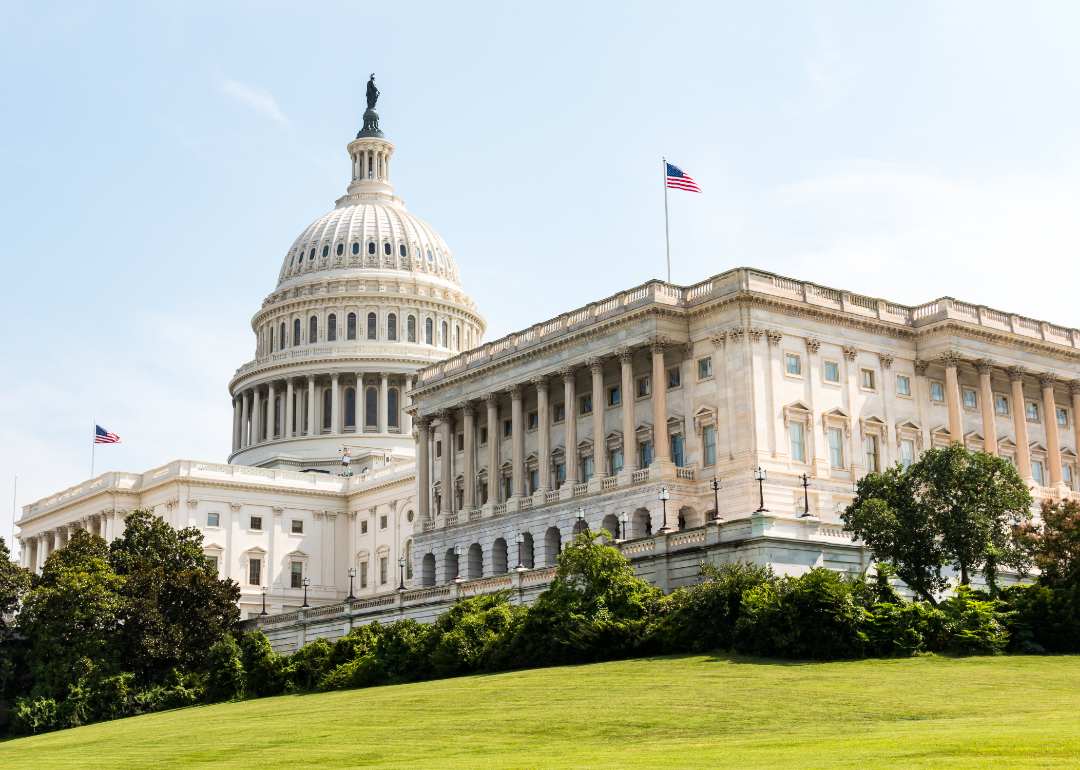
How congressional control has changed over the past 100 years
How congressional control has changed over the past 100 years
With partisan divisions and rancor filling the headlines, it seems like a miracle that Congress can get anything done.
Party control of Congress makes a difference, but not always in predictable ways. When one party holds majorities in the Senate and House of Representatives and holds the presidency, it's not necessarily easier for all to agree on legislative remedies and reforms. By the same token, when the congressional chambers are split, or the executive is in the opposing party, plenty can be accomplished.
Stacker consulted government records, news reports, historical archives, and research data as of Jan. 7 to look at how party control of Congress has affected outcomes in the past century and how it has changed. Data from the official websites of the U.S. House of Representatives and the U.S. Senate, as well as data from Ballotpedia and 270toWin, was used to look back on the past 100 years of Congress. Each slide represents a House term of two years and breaks down how many Democrats and Republicans were in each chamber of Congress.
Split congresses dramatically overhauled the nation's tax code when Ronald Reagan was president, passed landmark legislation addressing equal pay in the workplace, and ended the "don't ask, don't tell" policy toward gays and lesbians serving in the U.S. military.
But acrimonious relations between a Republican Congress and Democratic President Bill Clinton forced the government to grind to a halt—twice.
Along expected party lines, Republican-controlled congresses have limited immigration, ordered the construction of giant energy projects, and created the Central Intelligence Agency. But Republican-controlled congresses also have protected workers' rights to organize unions, created the Department of Health, Education and Welfare, and rejected energy proposals by fellow Republican President George W. Bush.
Democrat-led congresses gave their hearty approval to President Franklin Delano Roosevelt's New Deal measures to help America recover from the Great Recession, but less than two decades later, rebuffed efforts by President Harry Truman to follow up with plans called a Fair Deal. Democratic Congresses created the Social Security Administration to help the elderly, the first federal minimum wage, and the Peace Corps but rejected energy reforms by fellow Democratic President Jimmy Carter.
In one unpredictable extraordinary election year, Republicans won control of the House, but by the time Congress convened, 14 House members had died. Democrats took control in the special elections held to fill their seats.
With the runoff election in Georgia giving narrow control of the Senate—in addition to the House of Representatives and the presidency—to the Democratic Party, only time will tell how members of Congress and incoming President Joe Biden will use this party control to their advantage. At stake are a number of polarizing social and economic issues, the most urgent one being the COVID-19 pandemic and its effects on both health care and the U.S. economy.
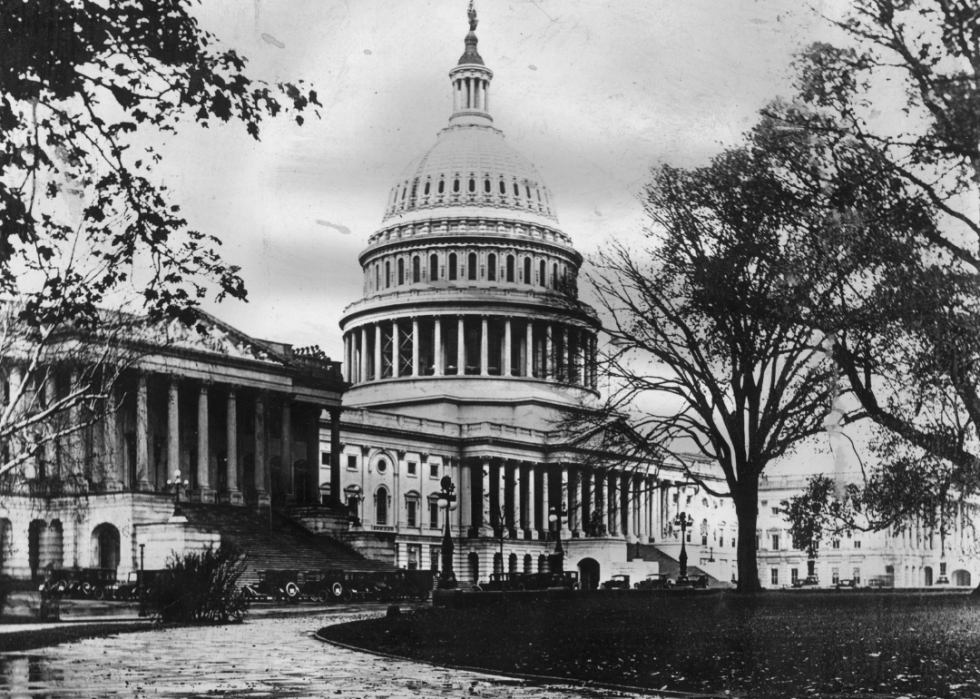
1923–1925: 68th Congress
Congress controlled by: Republicans
- Senate breakdown: 43 Democrats, 51 Republicans, 2 others, 0 vacancies
--- Senate controlled by: Republicans
- House of Representatives breakdown: 207 Democrats, 225 Republicans, 3 others, 0 vacancies
--- House controlled by: Republicans
- President during 1923–1925: Calvin Coolidge
The Republican-controlled Congress strengthened the Federal Corrupt Practices Act governing campaign finance, a measure that would set the standards until 1971. It also passed the Immigration Act of 1924, which limited the number of immigrants based upon a national quota system and excluded Asian immigrants entirely.
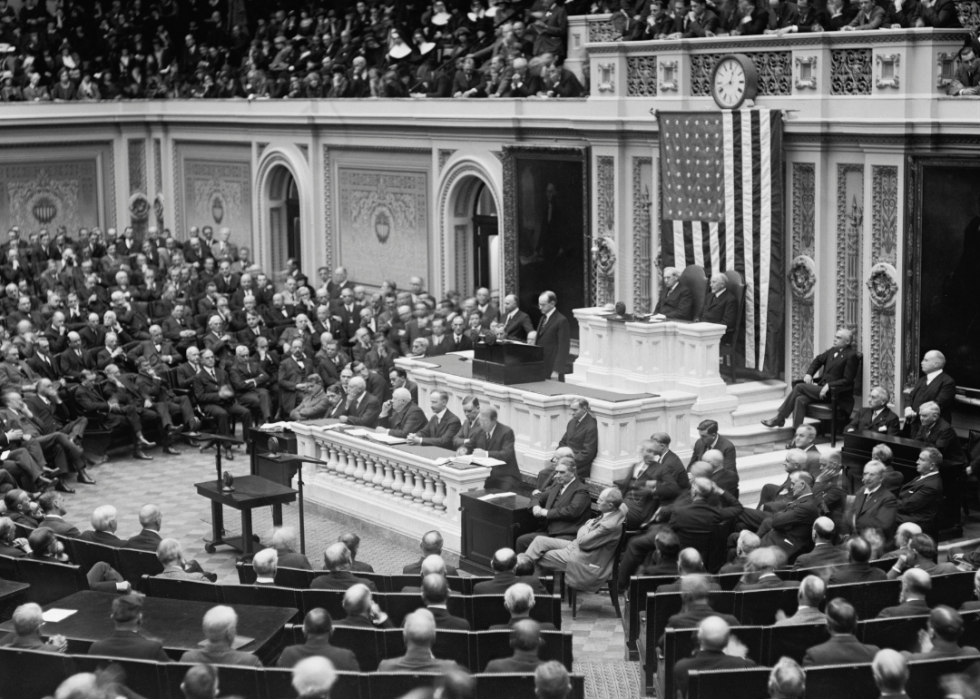
1925–1927: 69th Congress
Congress controlled by: Republicans
- Senate breakdown: 40 Democrats, 54 Republicans, 1 other, 1 vacancies
--- Senate controlled by: Republicans
- House of Representatives breakdown: 183 Democrats, 247 Republicans, 5 others, 0 vacancies
--- House controlled by: Republicans
- President during 1925–1927: Calvin Coolidge
With Republicans controlling the Senate, House and the White House, Congress passed the Railway Labor Act, which was designed to limit the threat of work stoppages that could interrupt interstate commerce. To avert strikes, the law called for collective bargaining, mediation and arbitration of disputes over pay, conditions, and work rules, and to protect workers' rights to unionize.
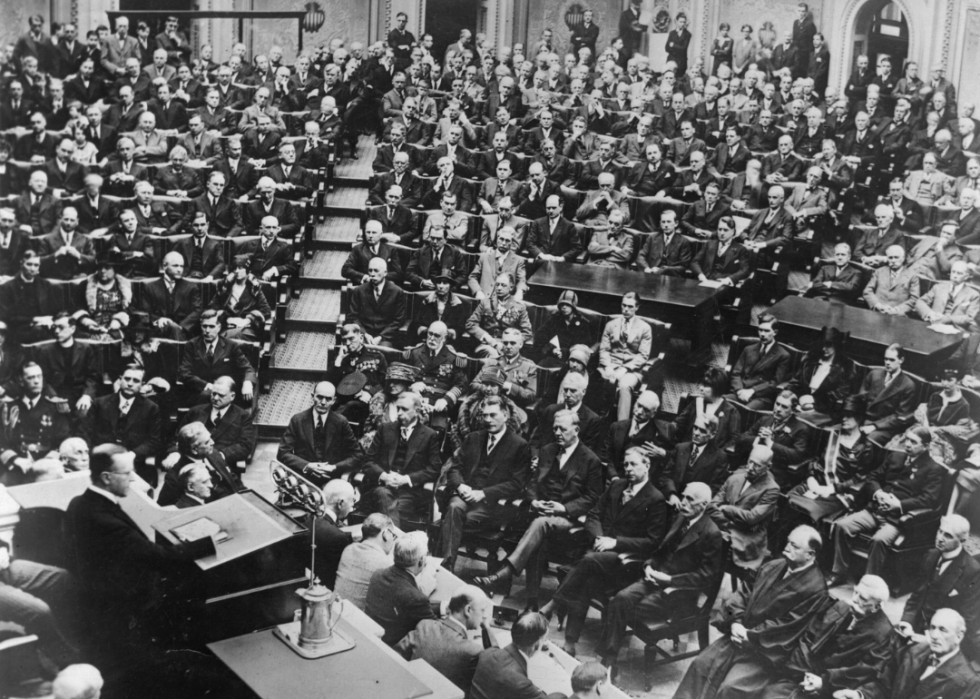
1927–1929: 70th Congress
Congress controlled by: Republicans
- Senate breakdown: 47 Democrats, 48 Republicans, 1 other, 0 vacancies
--- Senate controlled by: Republicans
- House of Representatives breakdown: 195 Democrats, 237 Republicans, 3 others, 0 vacancies
--- House controlled by: Republicans
- President during 1927–1929: Calvin Coolidge
Republicans retained control of Congress, but lost a significant number of House and Senate seats in the 1926 elections. In the wake of a devastating Mississippi River flood in 1927, Congress passed the Flood Control Act the following year to address levee construction, channels, and spillways. Significantly, under the law, the federal government cannot be held liable for flood damage. Congress also approved construction of the Hoover Dam to control flooding on the Colorado River and to generate electrical power.
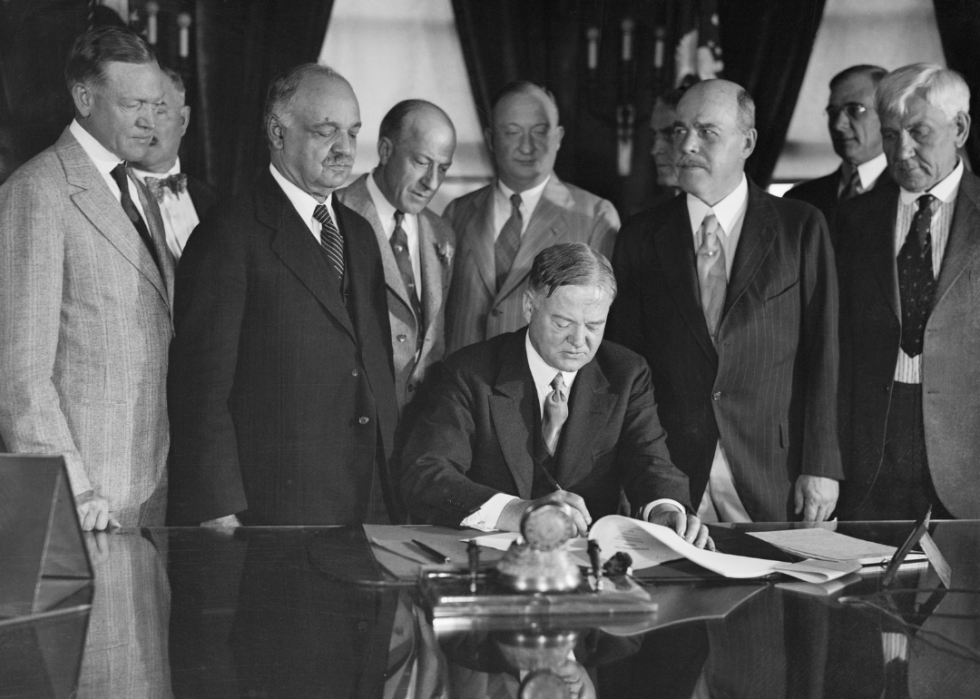
1929–1931: 71st Congress
Congress controlled by: Republicans
- Senate breakdown: 39 Democrats, 56 Republicans, 1 other, 0 vacancies
--- Senate controlled by: Republicans
- House of Representatives breakdown: 163 Democrats, 267 Republicans, 1 other, 4 vacancies
--- House controlled by: Republicans
- President during 1929–1931: Herbert Hoover
Grappling with the nation's economic crisis, Congress passed the disastrous Smoot-Hawley Tariff. Republicans who controlled the House Ways and Means Committee promoted the measure, which hiked import tariffs to raise federal revenues, and over vocal opposition, Hoover signed it into law in 1930. International trading partners responded by raising their tariffs, worsening the Great Depression. Congress also adopted "The Star-Spangled Banner" as the U.S. national anthem.
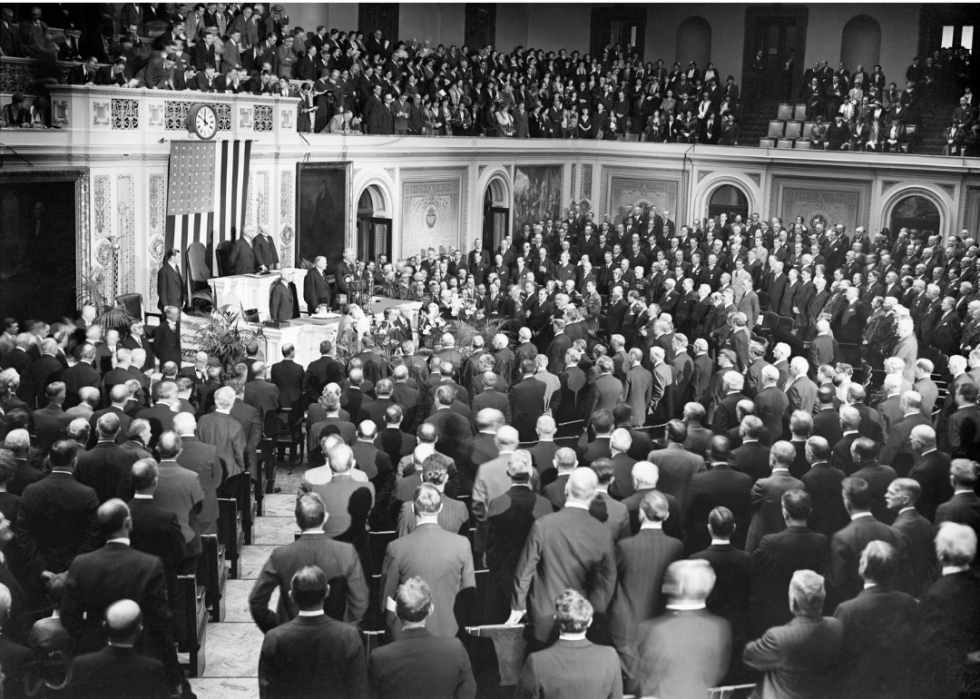
1931–1933: 72nd Congress
Congress controlled by: Split
- Senate breakdown: 47 Democrats, 48 Republicans, 1 other, 0 vacancies
--- Senate controlled by: Republicans
- House of Representatives breakdown: 217 Democrats, 217 Republicans, 1 other, 0 vacancies
--- House controlled by: Democrats
- President during 1931–1933: Herbert Hoover
Republicans won a slight majority in the House in the 1930 elections, but by the time the 72nd Congress convened, 14 Representatives had died. Democrats gained ground in the special elections to fill the seats as voters showed their unhappiness with the worsening depression and the response of the Hoover administration. After panicking customers rushed to access their deposits and many banks failed, Congress established the Reconstruction Finance Corporation in 1932 to boost and restore confidence in the banking system by making loans to banks and railroads.
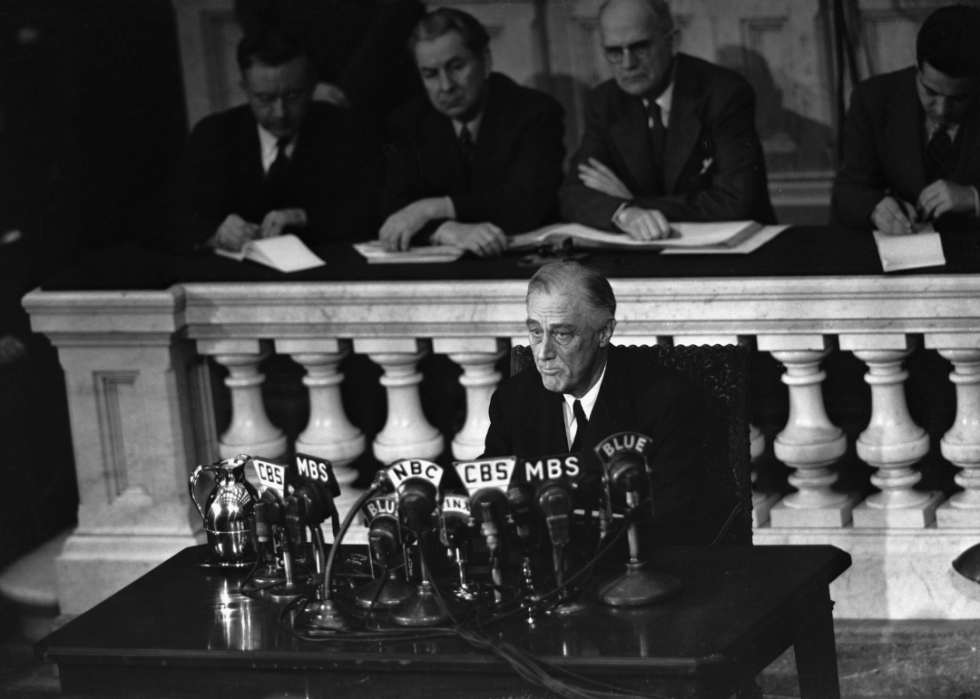
1933–1935: 73rd Congress
Congress controlled by: Democrats
- Senate breakdown: 59 Democrats, 36 Republicans, 1 other, 0 vacancies
--- Senate controlled by: Democrats
- House of Representatives breakdown: 313 Democrats, 117 Republicans, 5 others, 0 vacancies
--- House controlled by: Democrats
- President during 1933–1935: Franklin D. Roosevelt
The Senate and House flipped to Democratic control, by large numbers, as did the White House as voters expressed their unhappiness for the government's handling of the Great Depression. To address the economic crisis, Congress approved President Franklin D. Roosevelt's New Deal measures that included large-scale infrastructure projects such as the Tennessee Valley Authority to build dams and electrical generation, created the Civilian Conservation Corps work relief program, reformed the banking system with passage of the Glass-Steagall Act that separated commercial from investment banking, and created the Federal Deposit Insurance Corporation and the Securities and Exchange Commission to oversee and regulate financial markets.
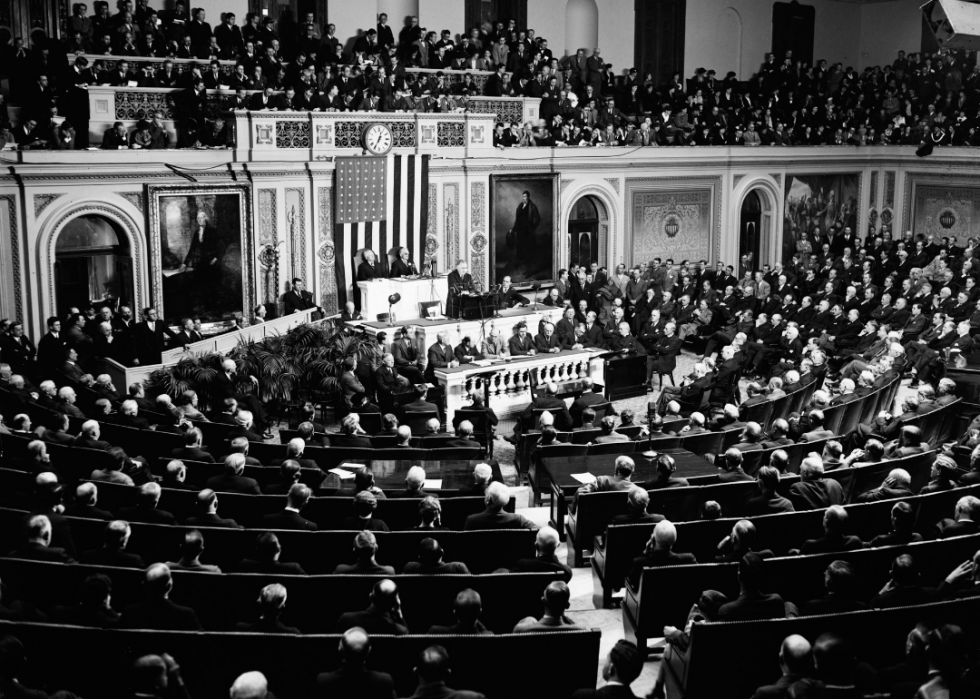
1935–1937: 74th Congress
Congress controlled by: Democrats
- Senate breakdown: 69 Democrats, 25 Republicans, 2 others, 0 vacancies
--- Senate controlled by: Democrats
- House of Representatives breakdown: 322 Democrats, 103 Republicans, 10 others, 0 vacancies
--- House controlled by: Democrats
- President during 1935–1937: Franklin D. Roosevelt
Democrats grew their majorities in both the House and Senate as voters showed their support for President Franklin D. Roosevelt's New Deal initiatives. A major development was the creation of the Social Security system to help support elderly Americans not with welfare, but based upon work-related tax contributions. Also significant was the Rural Electrification Act of 1936 to bring power to the nation's farms. One of the New Deal's biggest and most successful projects—the Rural Electrification Administration—oversaw the delivery of electricity to 1.5 million farms within two years, fueled the manufacturing of home appliances, and accelerated growth of the suburbs.
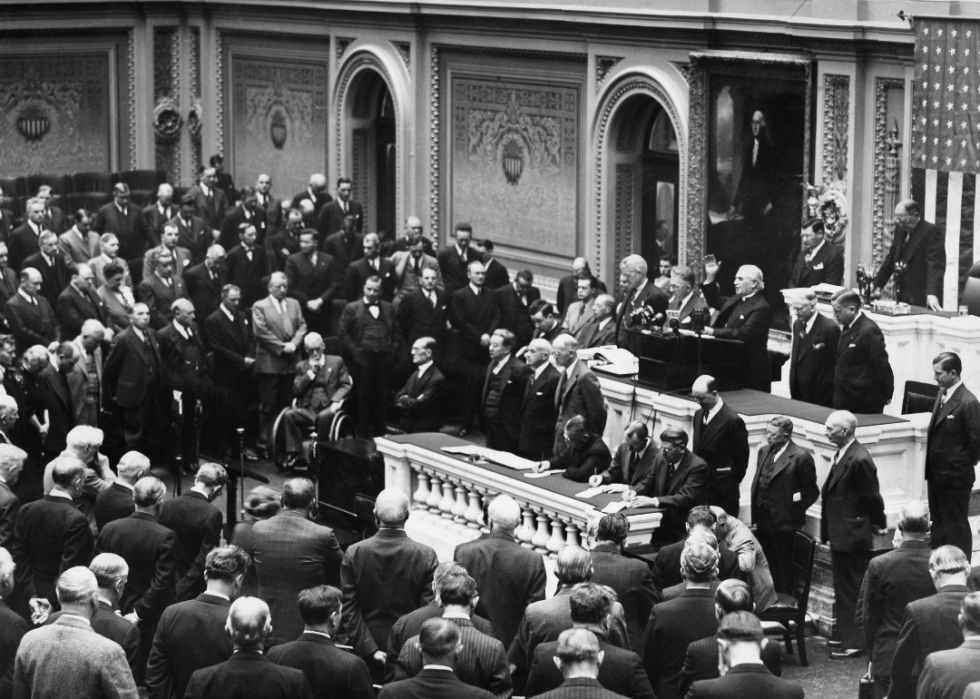
1937–1939: 75th Congress
Congress controlled by: Democrats
- Senate breakdown: 76 Democrats, 16 Republicans, 4 others, 0 vacancies
--- Senate controlled by: Democrats
- House of Representatives breakdown: 333 Democrats, 89 Republicans, 13 others, 0 vacancies
--- House controlled by: Democrats
- President during 1937–1939: Franklin D. Roosevelt
With Democrats still holding large majorities, Congress approved the Fair Labor Standards Act, which was signed into law in 1938 after lengthy legal and legislative opposition. The act banned child labor, set a maximum work week of 44 hours, and established a federal minimum wage of 25 cents an hour. In an acknowledgement of growing hostilities in both Europe and Asia, lawmakers also took the first steps to building a so-called two-ocean U.S. Navy, expanding its size and strength with added equipment, vessels, reserves, and officer enrollment.
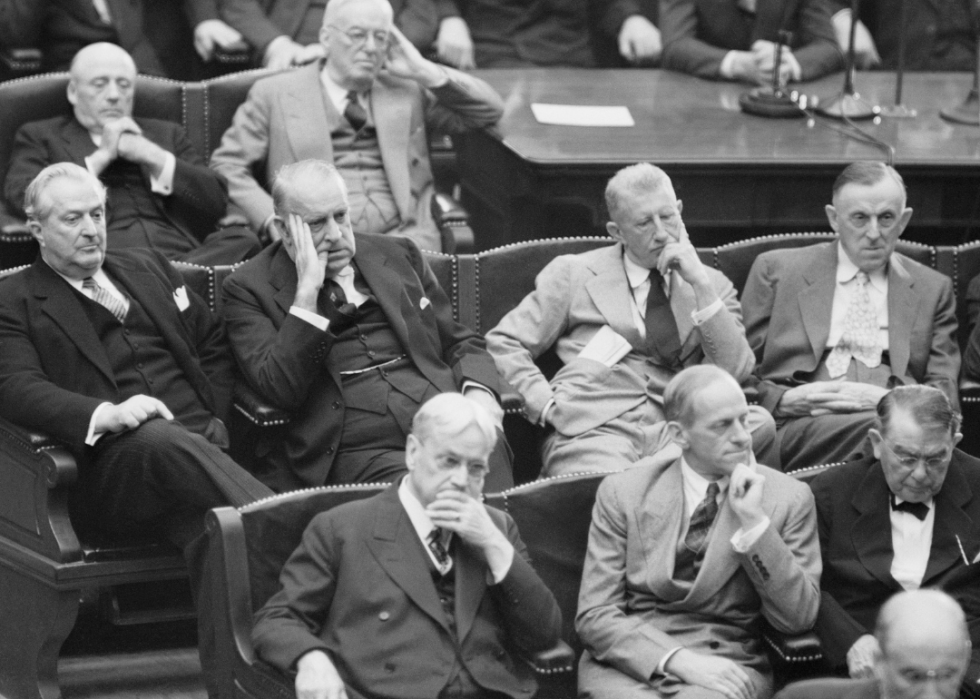
1939–1941: 76th Congress
Congress controlled by: Democrats
- Senate breakdown: 69 Democrats, 23 Republicans, 4 others, 0 vacancies
--- Senate controlled by: Democrats
- House of Representatives breakdown: 261 Democrats, 169 Republicans, 5 others, 0 vacancies
--- House controlled by: Democrats
- President during 1939–1941: Franklin D. Roosevelt
Democrats lost seats, but retained sizable majorities in both houses of Congress, which was occupied mostly with addressing issues linked to the war that broke out in Europe in the spring of 1940. Lawmakers added military appropriations, authorized construction of munitions plants, and implemented policies for the trade of war supplies with countries fighting Germany, measures to register and fingerprint aliens, and the first peace-time draft.
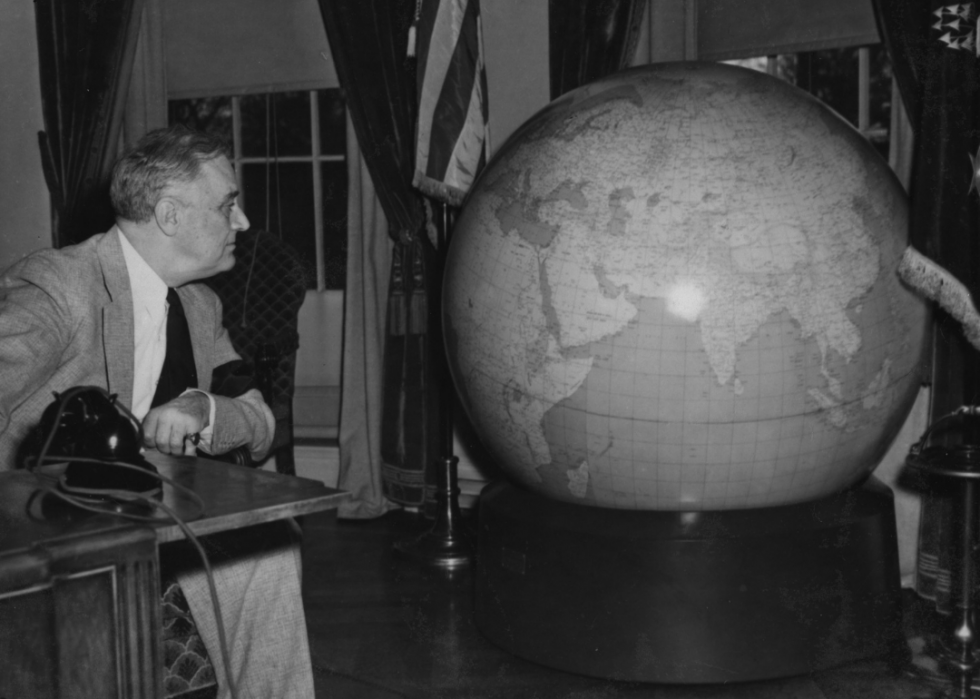
1941–1943: 77th Congress
Congress controlled by: Democrats
- Senate breakdown: 66 Democrats, 28 Republicans, 2 others, 0 vacancies
--- Senate controlled by: Democrats
- House of Representatives breakdown: 268 Democrats, 162 Republicans, 5 others, 0 vacancies
--- House controlled by: Democrats
- President during 1941–1943: Franklin D. Roosevelt
Democrats kept control of Congress as President Franklin D. Roosevelt was elected to an unprecedented third term. After the Japanese bombing of Pearl Harbor in December 1941, Congress declared war on Japan, Germany, and Italy. Lawmakers also approved the Lend-Lease Act, allowing the country to provide airplanes, ammunition, tanks, and other material to Great Britain without violating the U.S. position of neutrality.
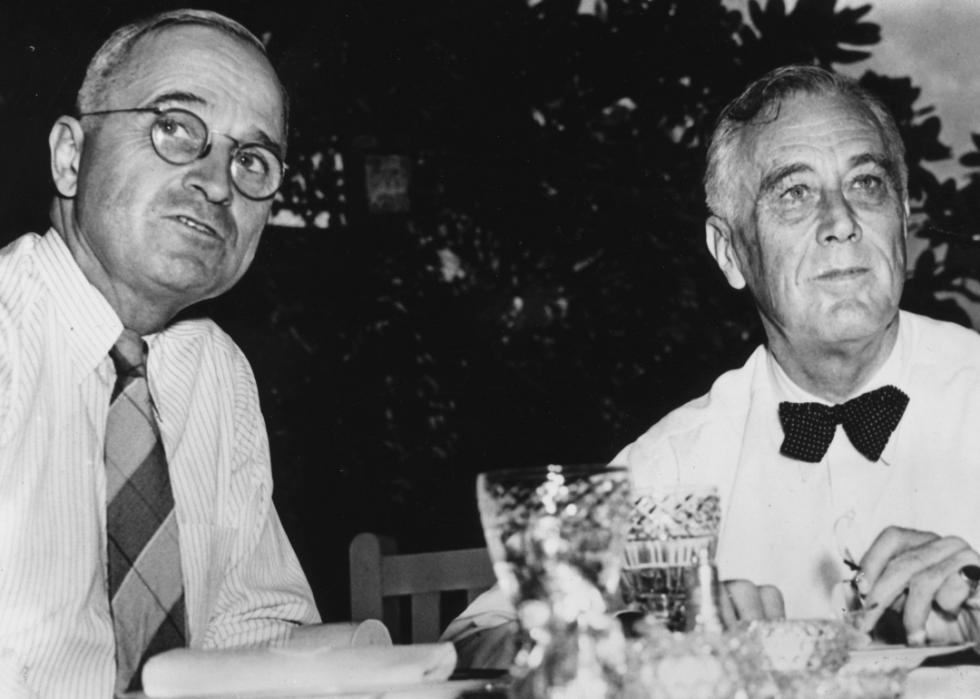
1943–1945: 78th Congress
Congress controlled by: Democrats
- Senate breakdown: 57 Democrats, 38 Republicans, 1 other, 0 vacancies
--- Senate controlled by: Democrats
- House of Representatives breakdown: 222 Democrats, 209 Republicans, 4 others, 0 vacancies
--- House controlled by: Democrats
- President during 1943–1945: Franklin D. Roosevelt
With shrinking Democratic majorities, Congress enacted the G.I. Bill of Rights, providing government-funded education opportunities, and loans for buying homes, farms, and businesses to veterans returning to civilian life. It authorized the Bracero Program in 1943 to recruit Mexican seasonal workers to address a shortage in agricultural laborers.
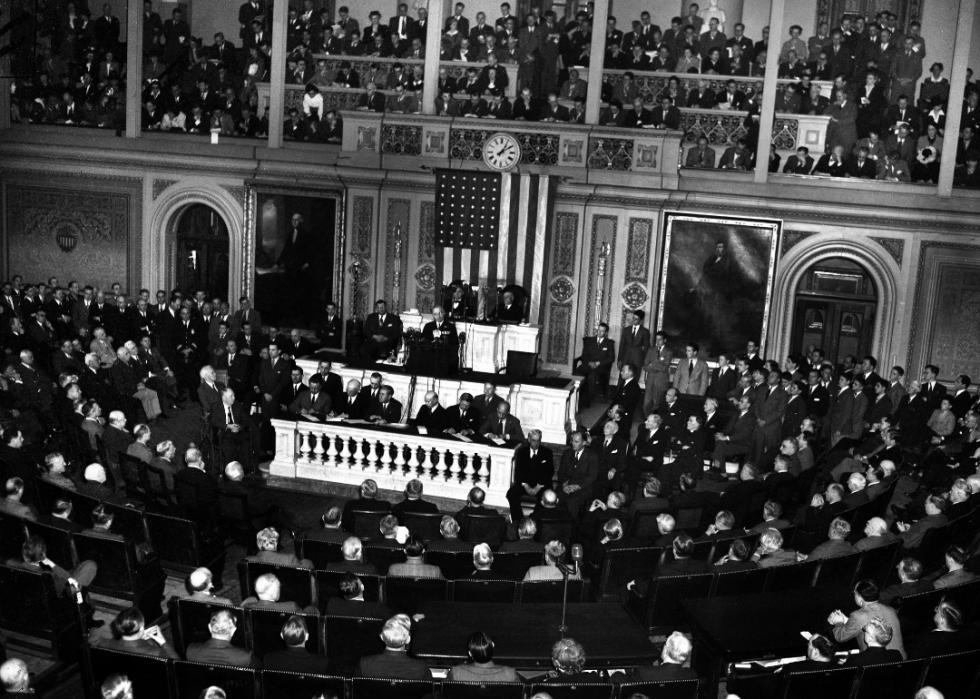
1945–1947: 79th Congress
Congress controlled by: Democrats
- Senate breakdown: 57 Democrats, 38 Republicans, 1 other, 0 vacancies
--- Senate controlled by: Democrats
- House of Representatives breakdown: 243 Democrats, 190 Republicans, 2 others, 0 vacancies
--- House controlled by: Democrats
- President during 1945–1947: Harry S. Truman
Still strongly Democratic, the post-war 79th Congress built up the nation's international role. Congress approved the United States joining the newly founded United Nations in 1945, the International Monetary Fund, and the World Bank. The Atomic Energy Act of 1946 was also passed, which laid out all-civilian control and ownership of atomic resources.
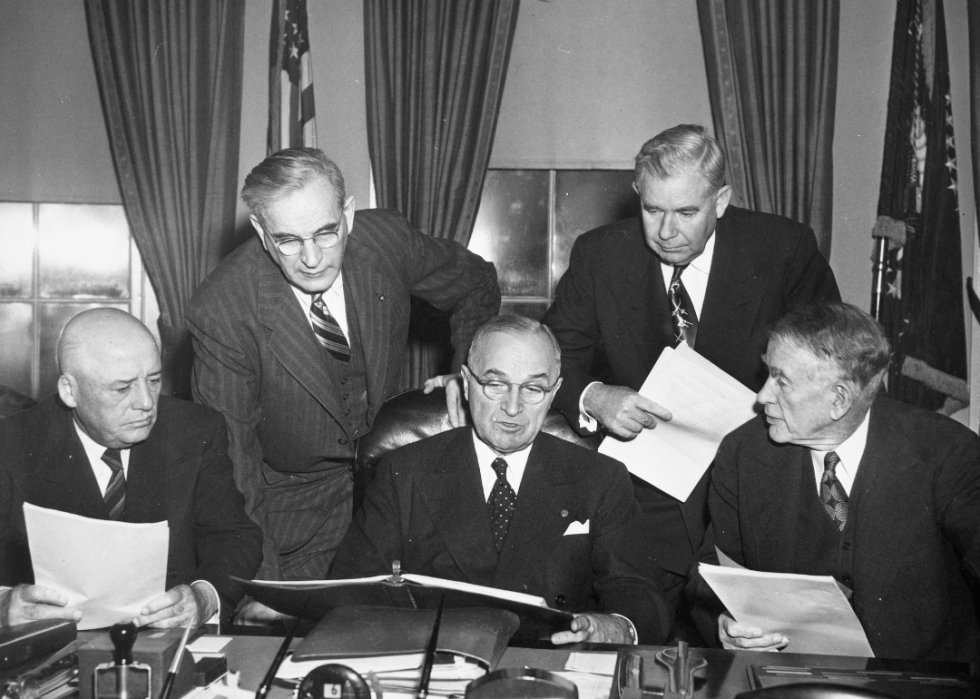
1947–1949: 80th Congress
Congress controlled by: Republicans
- Senate breakdown: 45 Democrats, 51 Republicans, 0 others, 0 vacancies
--- Senate controlled by: Republicans
- House of Representatives breakdown: 188 Democrats, 246 Republicans, 1 other, 0 vacancies
--- House controlled by: Republicans
- President during 1947–1949: Harry S. Truman
Republicans regained majorities in both houses after 15 years. Congress approved a constitutional amendment limiting presidents to two terms after Roosevelt had been elected to four terms, and passed the Taft-Hartley Act putting limits on the powers of labor unions. It created the Central Intelligence Agency under the National Security Act of 1947, and, looking abroad, it passed the European Recovery Program, better known as the Marshall Plan, to help rebuild war-ravaged cities, infrastructure, and industries in Europe.
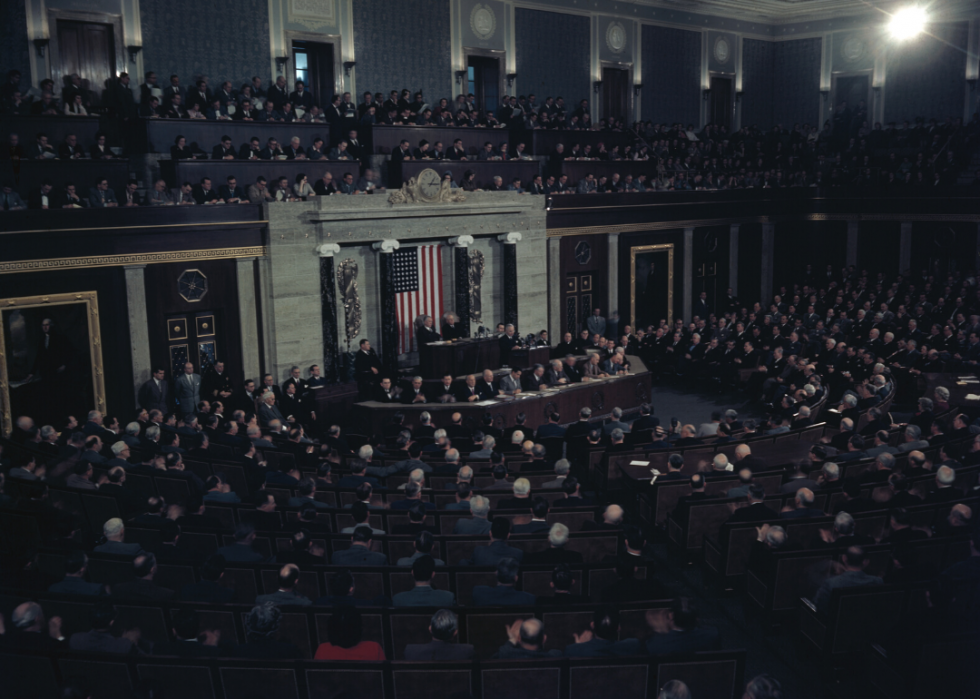
1949–1951: 81st Congress
Congress controlled by: Democrats
- Senate breakdown: 54 Democrats, 42 Republicans, 0 others, 0 vacancies
--- Senate controlled by: Democrats
- House of Representatives breakdown: 262 Democrats, 171 Republicans, 2 others, 0 vacancies
--- House controlled by: Democrats
- President during 1949–1951: Harry S. Truman
Congress flipped back to Democratic control, focusing on national security after the successful testing of an atomic bomb by the Soviet Union. It approved the nation's entry in the North Atlantic Treaty Organization, designed to protect Western Europe. President Harry Truman tried to pass a so-called Fair Deal package to follow up on former President Franklin D. Roosevelt's New Deal, but most of the measures, except for a public housing bill, did not win enough support for approval.
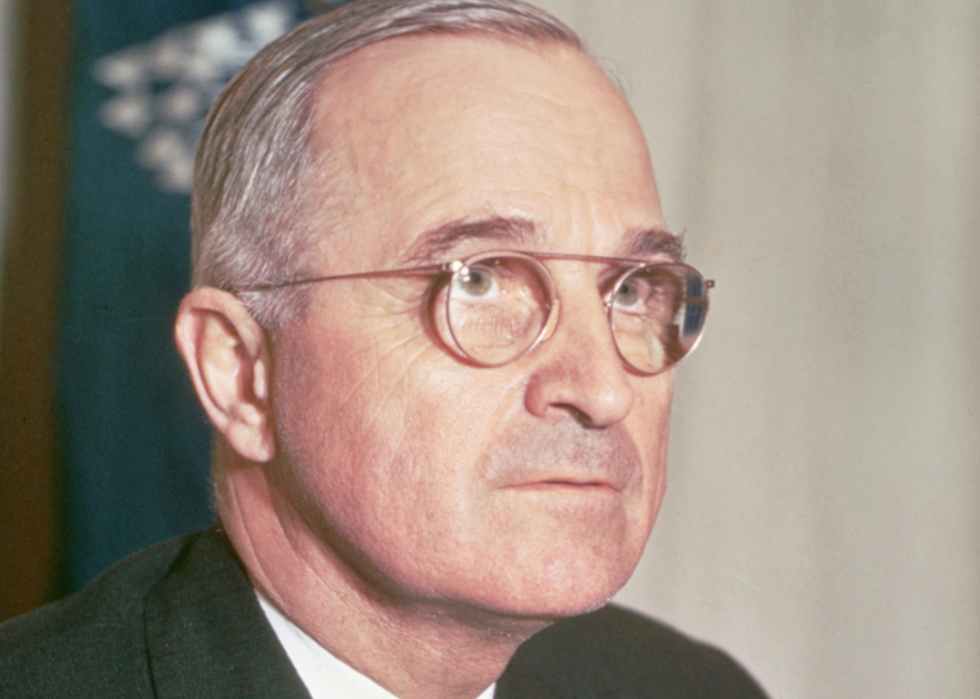
1951–1953: 82nd Congress
Congress controlled by: Democrats
- Senate breakdown: 48 Democrats, 47 Republicans, 1 other, 0 vacancies
--- Senate controlled by: Democrats
- House of Representatives breakdown: 235 Democrats, 199 Republicans, 1 other, 0 vacancies
--- House controlled by: Democrats
- President during 1951–1953: Harry S. Truman
The 82nd Congress was focused largely on the war in Korea, especially after U.S. and Republic of Korea forces were forced back from positions near the Chinese border by brutal counterattacks by the Chinese People's Liberation Army, and the war became a tense standoff at the North Korean border. Domestically, a strike by steelworkers was underway, but Congress turned back an effort by Truman for the government to take over control of the mills. In Washington D.C., absenteeism in Congress, as a number of members were making presidential bids or concentrating on reelection, made it difficult to assemble quorums, and votes that Democrats would otherwise have won failed due to their lack of attendance.
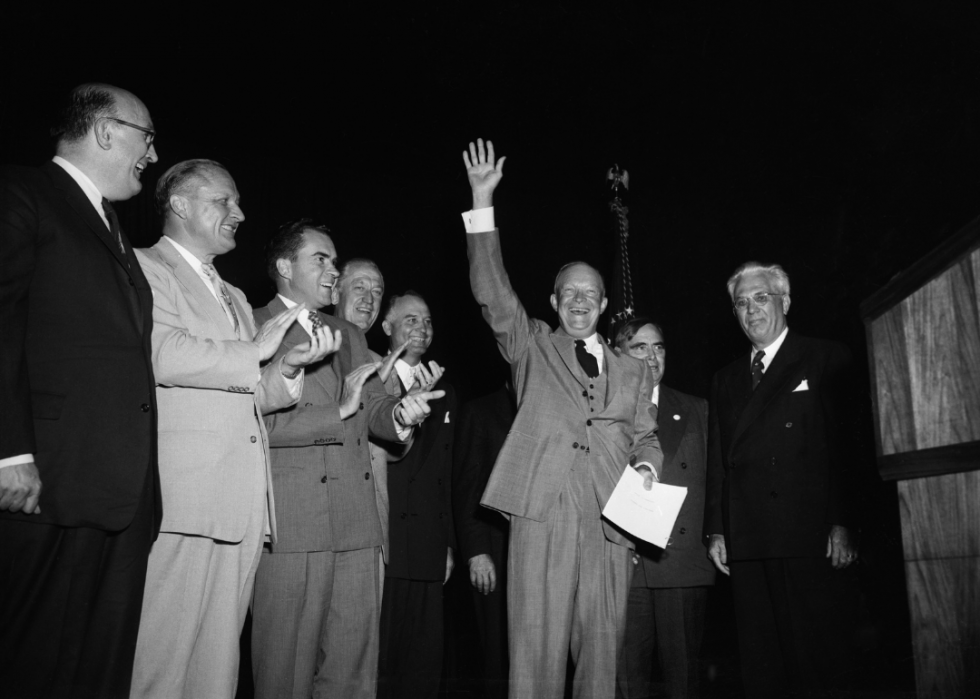
1953–1955: 83rd Congress
Congress controlled by: Republicans
- Senate breakdown: 46 Democrats, 48 Republicans, 2 others, 0 vacancies
--- Senate controlled by: Republicans
- House of Representatives breakdown: 213 Democrats, 221 Republicans, 1 other, 0 vacancies
--- House controlled by: Republicans
- President during 1953–1955: Dwight D. Eisenhower
Republicans held sway in Congress and in the White House for the first time since 1928. Lawmakers created the Department of Health, Education, and Welfare and made a deal with Canada to construct the St. Lawrence Seaway. The Atomic Energy Act of 1954 gave the Atomic Energy Commission oversight responsibility for commercial atomic activities, with plans for private industry to build nuclear power reactors, and allowed for the sharing of nuclear technology with other countries.
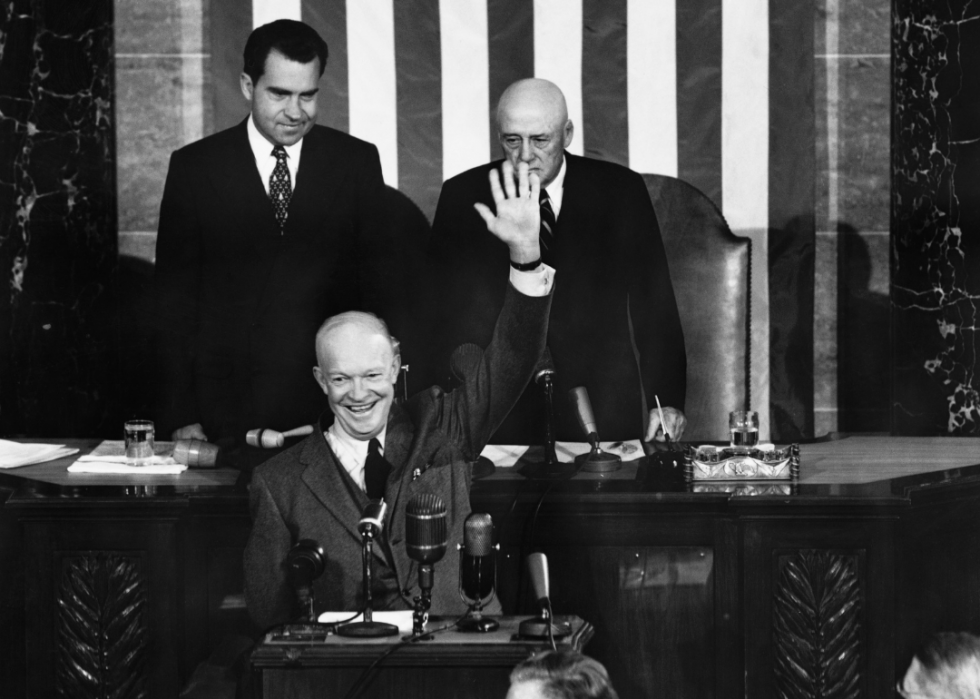
1955–1957: 84th Congress
Congress controlled by: Democrats
- Senate breakdown: 48 Democrats, 47 Republicans, 1 other, 0 vacancies
--- Senate controlled by: Democrats
- House of Representatives breakdown: 232 Democrats, 203 Republicans, 0 others, 0 vacancies
--- House controlled by: Democrats
- President during 1955–1957: Dwight D. Eisenhower
Democrats took back control of both houses in the 84th Congress, which gave President Dwight D. Eisenhower powers to help protect Taiwan from Communist Chinese invasion with the Formosa and Pescadores Joint Resolution. The Federal-Aid Highway Act authorized the construction of 41,000 miles of interstate highways, the nation's biggest public works program to date. It was to be funded predominantly by the federal government through taxes on fuel, tires, trucks, and buses.
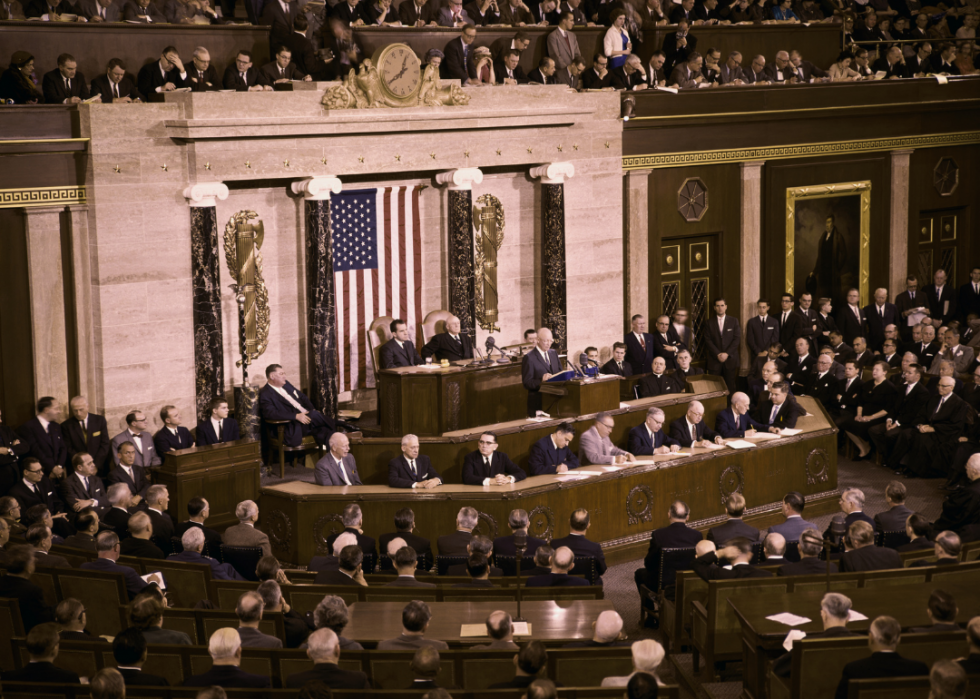
1957–1959: 85th Congress
Congress controlled by: Democrats
- Senate breakdown: 49 Democrats, 47 Republicans, 0 others, 0 vacancies
--- Senate controlled by: Democrats
- House of Representatives breakdown: 234 Democrats, 201 Republicans, 0 others, 0 vacancies
--- House controlled by: Democrats
- President during 1957–1959: Dwight D. Eisenhower
Congress launched the National Aeronautics and Space Administration (NASA) after the Soviet Union successfully sent a satellite into orbit in 1957 and kicked off the international space race. Also in response to the Soviet maneuver, Congress passed the National Defense Education Act to fund and improve the teaching of science, math, and foreign languages. Statehood for Alaska was approved in 1958.
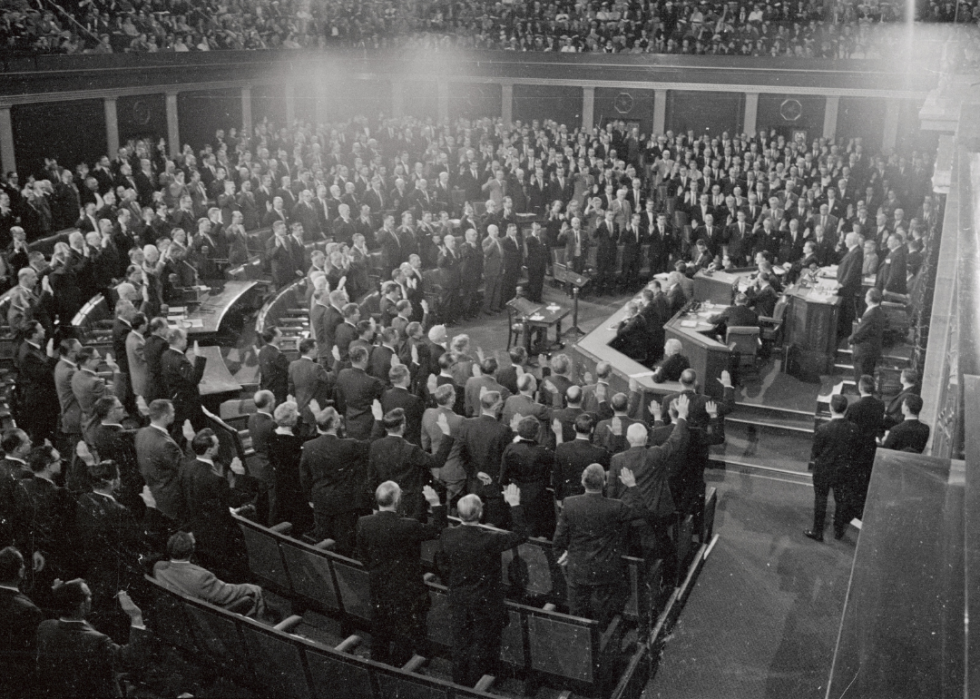
1959–1961: 86th Congress
Congress controlled by: Democrats
- Senate breakdown: 64 Democrats, 34 Republicans, 0 others, 0 vacancies
--- Senate controlled by: Democrats
- House of Representatives breakdown: 284 Democrats, 153 Republicans, 0 others, 0 vacancies
--- House controlled by: Democrats
- President during 1959–1961: Dwight D. Eisenhower
Democrats strengthened their majorities in Congress as voters grappled with a recession. Congressional lawmakers passed the Landrum-Griffin Labor-Management Reporting and Disclosure Act in an effort to rid labor unions of involvement by organized crime, approved statehood for Hawaii, and gave residents of the District of Columbia the right to vote in national elections.
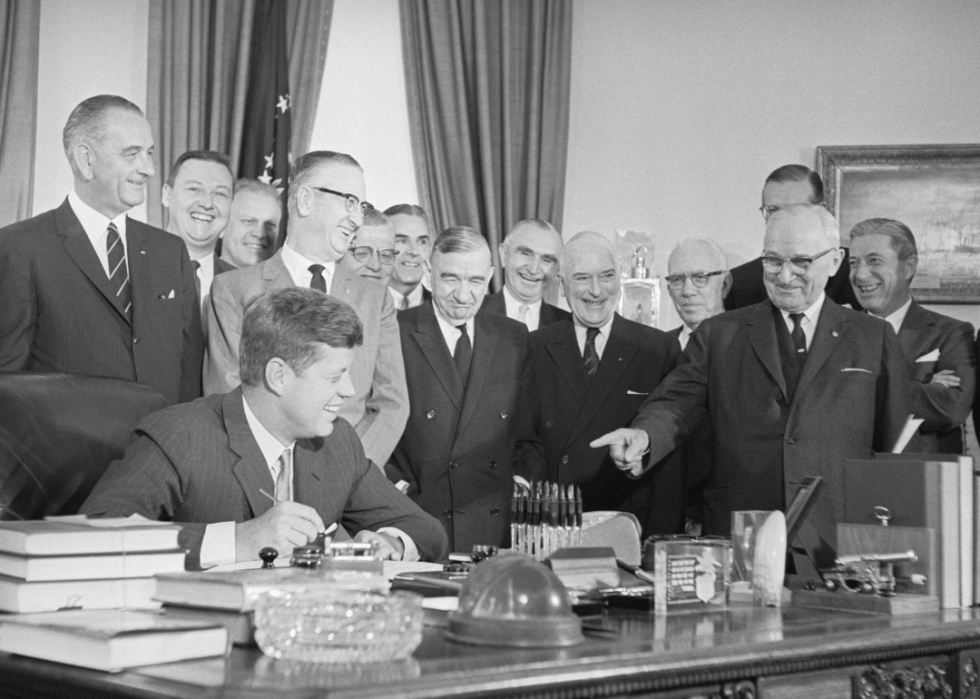
1961–1963: 87th Congress
Congress controlled by: Democrats
- Senate breakdown: 64 Democrats, 36 Republicans, 0 others, 0 vacancies
--- Senate controlled by: Democrats
- House of Representatives breakdown: 262 Democrats, 175 Republicans, 0 others, 0 vacancies
--- House controlled by: Democrats
- President during 1961–1963: John F. Kennedy
The Democrats' majorities grew smaller, but they held Congress and the White House. In the House, three seats were added to the powerful Rules Committee which oversees the flow of legislation to the floor. The increase to 15 seats was an effort by Democrats that had struggled to get liberal reform bills to the floor. The strategic move was steered by Texas Sen. Sam Rayburn, who died after serving the longest time—17 years—as House Speaker. Congress also founded the Peace Corps to send volunteer workers to developing countries and strengthened the regulatory powers of the Food and Drug Administration.

1963–1965: 88th Congress
Congress controlled by: Democrats
- Senate breakdown: 67 Democrats, 33 Republicans, 0 others, 0 vacancies
--- Senate controlled by: Democrats
- House of Representatives breakdown: 258 Democrats, 176 Republicans, 0 others, 1 vacancies
--- House controlled by: Democrats
- President during 1963–1965: Lyndon B. Johnson
In the wake of the Cuban missile crisis that brought the world perilously close to nuclear war, Congress approved the U.S. signing of the Nuclear Test Ban Treaty with Great Britain and the Soviet Union. It also tackled domestic issues with the Civil Rights Act of 1964 after the assassination of President John F. Kennedy, one of its strongest advocates, the Clean Air Act, and the Wilderness Act.
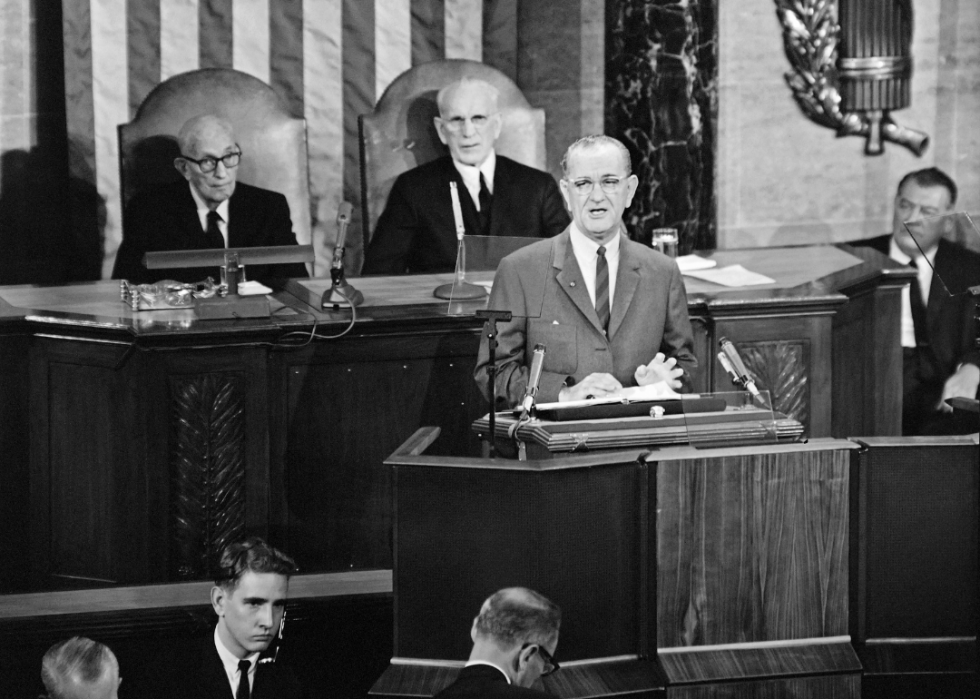
1965–1967: 89th Congress
Congress controlled by: Democrats
- Senate breakdown: 68 Democrats, 32 Republicans, 0 others, 0 vacancies
--- Senate controlled by: Democrats
- House of Representatives breakdown: 295 Democrats, 140 Republicans, 0 others, 0 vacancies
--- House controlled by: Democrats
- President during 1965–1967: Lyndon B. Johnson
With a sizable Democratic majority in the House, a two-thirds Democratic majority in the Senate, and a landslide election victory by President Lyndon B. Johnson, Congress pushed through a raft of domestic reform measures that the president coined "The Great Society" program. The bills supported voting rights, aid to the poor and elderly, education, clear air and water, and highway safety. The Democratic majority, the largest since 1936, allowed the party to quell opposition from Southern conservatives.
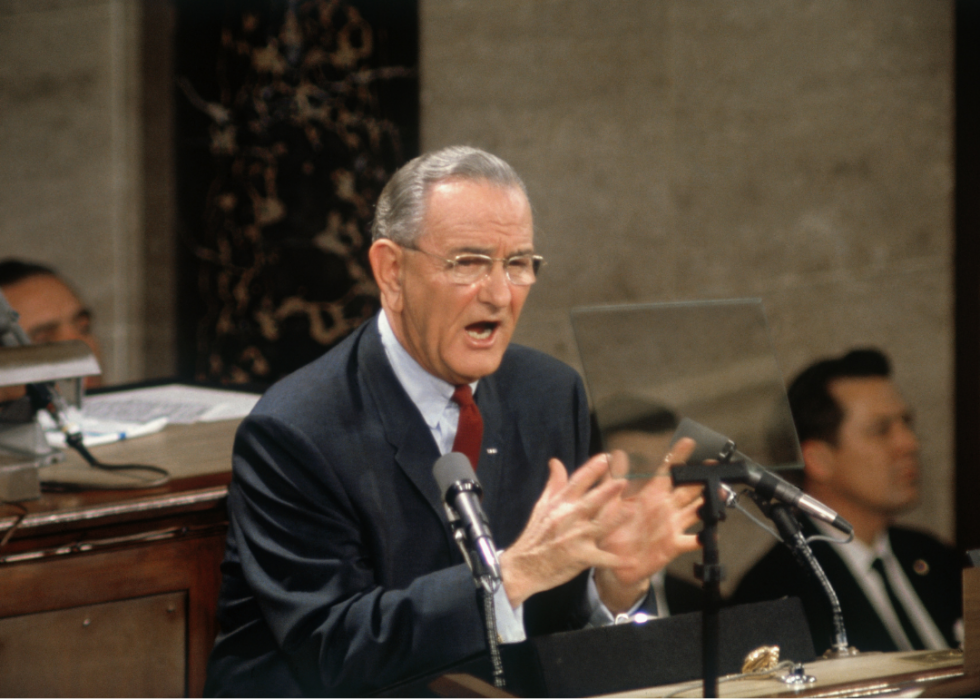
1967–1969: 90th Congress
Congress controlled by: Democrats
- Senate breakdown: 64 Democrats, 36 Republicans, 0 others, 0 vacancies
--- Senate controlled by: Democrats
- House of Representatives breakdown: 247 Democrats, 187 Republicans, 0 others, 1 vacancies
--- House controlled by: Democrats
- President during 1967–1969: Lyndon B. Johnson
Democratic majorities remained, but slipped in both houses. Against a backdrop of growing public consternation over the war in Vietnam, Congress launched the nation's public broadcasting system and federal clean air protections. In the wake of the slaying of civil rights leader Martin Luther King Jr., Congress banned mail-order and interstate gun and ammunition sales; prohibited felons, drug addicts, and minors from buying firearms; and required gun dealers to keep records of ammunition sales.
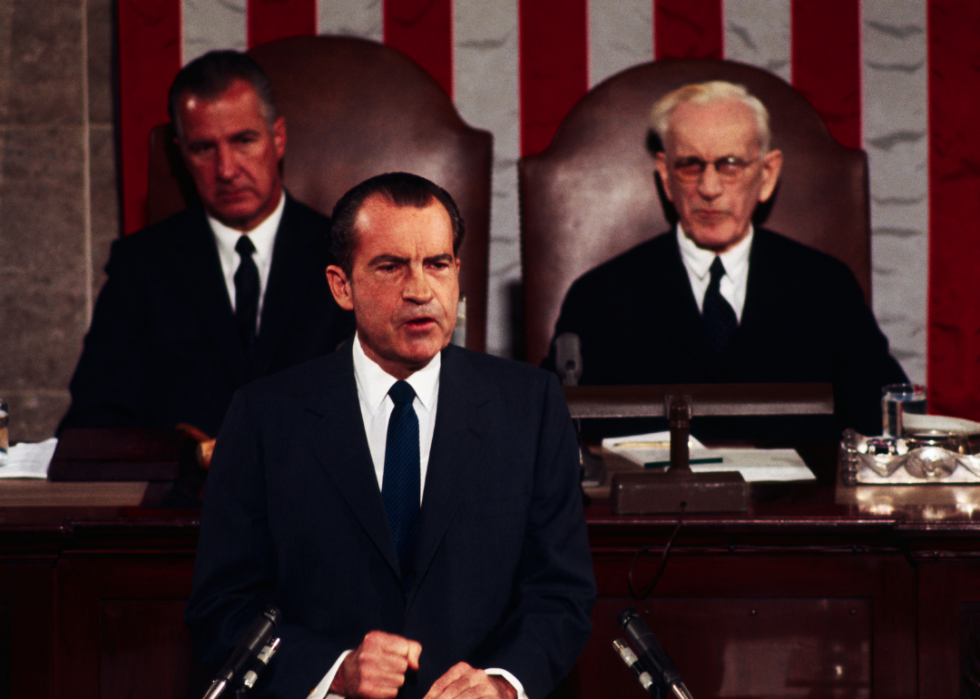
1969–1971: 91st Congress
Congress controlled by: Democrats
- Senate breakdown: 58 Democrats, 42 Republicans, 0 others, 0 vacancies
--- Senate controlled by: Democrats
- House of Representatives breakdown: 243 Democrats, 192 Republicans, 0 others, 0 vacancies
--- House controlled by: Democrats
- President during 1969–1971: Richard Nixon
During the 91st Congress, controlled by Democrats, but with a Republican in the White House, the nation was in the grips of urban race riots, a recession, and a political crisis over the war in Vietnam, which President Richard Nixon escalated by sending U.S. troops into Cambodia. Contentious relations between legislators and the president led to the defeat of Nixon's effort at welfare reform and two of his nominees to the U.S. Supreme Court.
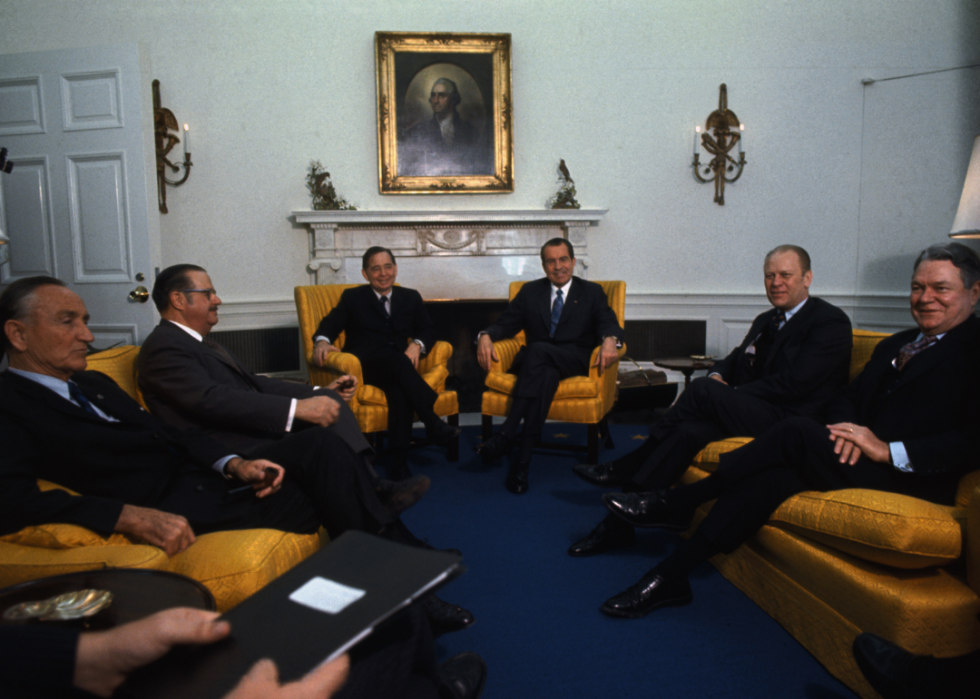
1971–1973: 92nd Congress
Congress controlled by: Democrats
- Senate breakdown: 54 Democrats, 44 Republicans, 2 others, 0 vacancies
--- Senate controlled by: Democrats
- House of Representatives breakdown: 255 Democrats, 180 Republicans, 0 others, 0 vacancies
--- House controlled by: Democrats
- President during 1971–1973: Richard Nixon
With the Democratic-controlled Congress at odds with the Republican president, lawmakers approved a resolution calling for troop withdrawal from Vietnam after Nixon escalated the conflict into Cambodia. It also passed the Equal Employment Opportunity Act of 1972, which boosted the authority of the Equal Employment Opportunity Commission to enforce federal laws against workplace discrimination. It lowered the voting age to 18, which the states ratified as the 26th Amendment to the Constitution.
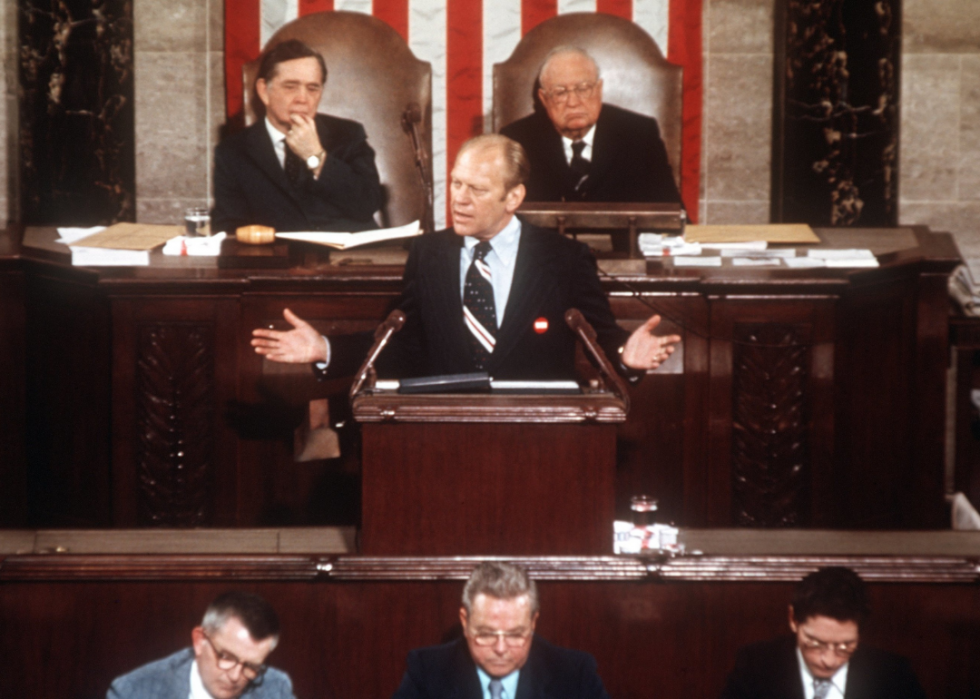
1973–1975: 93rd Congress
Congress controlled by: Democrats
- Senate breakdown: 56 Democrats, 42 Republicans, 2 others, 0 vacancies
--- Senate controlled by: Democrats
- House of Representatives breakdown: 243 Democrats, 192 Republicans, 0 others, 0 vacancies
--- House controlled by: Democrats
- President during 1973–1975: Gerald Ford
The Democratic-controlled 93rd Congress was occupied with investigations and hearings into the Watergate scandal, after a break-in at Democratic Party offices implicated top White House and Republican campaign officials. A number of them were indicted, convicted, and imprisoned, while Richard Nixon resigned in 1974 before the House could file articles of impeachment.
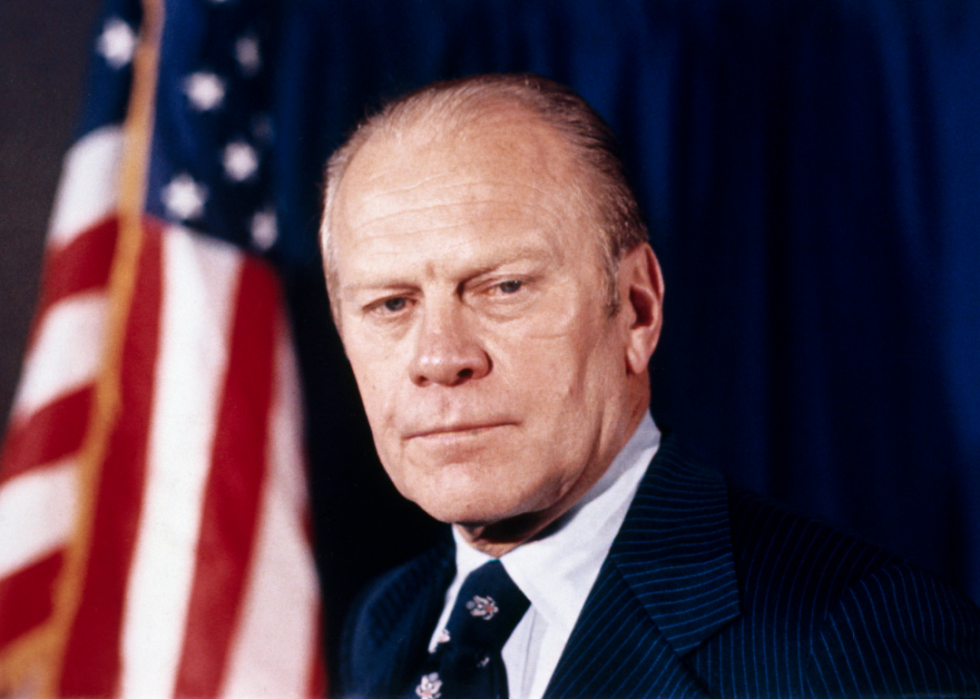
1975–1977: 94th Congress
Congress controlled by: Democrats
- Senate breakdown: 61 Democrats, 37 Republicans, 2 others, 0 vacancies
--- Senate controlled by: Democrats
- House of Representatives breakdown: 291 Democrats, 144 Republicans, 0 others, 0 vacancies
--- House controlled by: Democrats
- President during 1975–1977: Gerald Ford
After the Watergate scandal and former President Richard Nixon's resignation soured voters' taste for the Republican party, Democrats made major gains in their Congressional majorities. Many of the dozens of Democratic newcomers helped cut funding for the unpopular and divisive Vietnam War, managing to maneuver past more senior legislators. The Class of '74 legislators also backed reforms that Congress had not been addressing, such as women's rights and alternative energy.
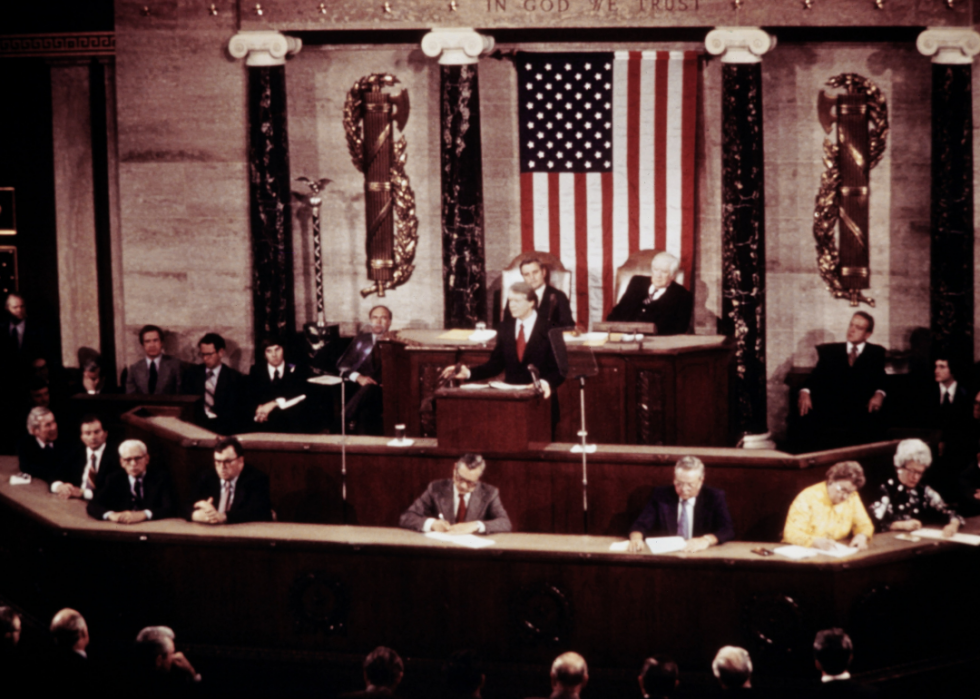
1977–1979: 95th Congress
Congress controlled by: Democrats
- Senate breakdown: 61 Democrats, 38 Republicans, 1 other, 0 vacancies
--- Senate controlled by: Democrats
- House of Representatives breakdown: 292 Democrats, 143 Republicans, 0 others, 0 vacancies
--- House controlled by: Democrats
- President during 1977–1979: Jimmy Carter
The 95th Congress, under Democratic control along with the White House following the election of Jimmy Carter, had mixed success in addressing the nation's energy crisis. It did not pass much of Carter's sweeping energy policy proposals, but it passed the Emergency Natural Gas Act overseeing the allocation of natural gas, and created the Department of Energy to regulate energy supplies and sources. It also abolished the Joint Committee on Atomic Energy, clearing the way for more control and oversight of nuclear power reactors.
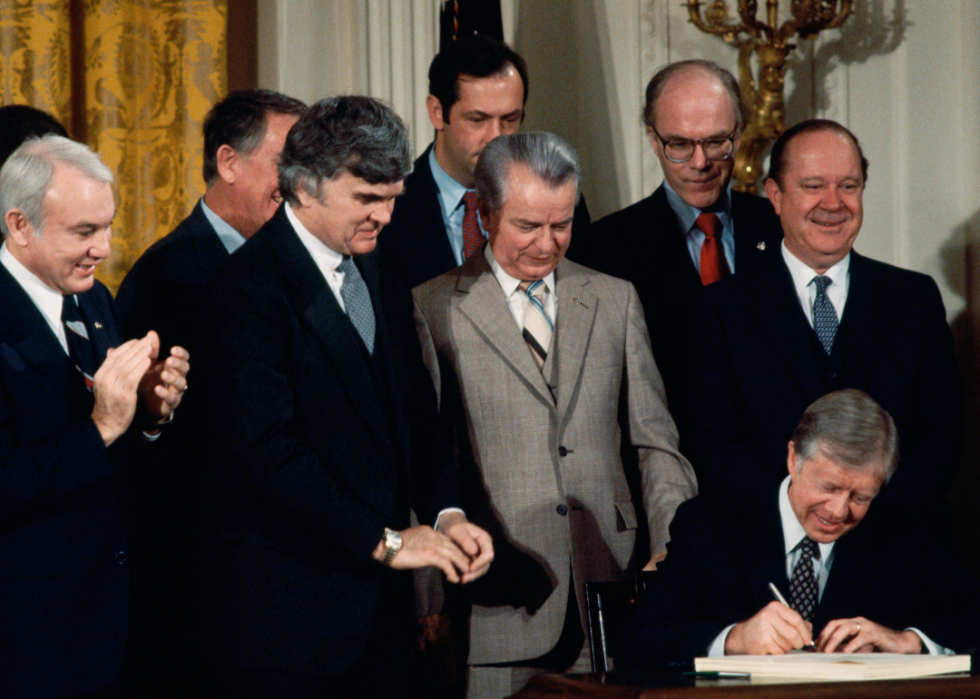
1979–1981: 96th Congress
Congress controlled by: Democrats
- Senate breakdown: 58 Democrats, 41 Republicans, 1 other, 0 vacancies
--- Senate controlled by: Democrats
- House of Representatives breakdown: 277 Democrats, 157 Republicans, 1 other, 0 vacancies
--- House controlled by: Democrats
- President during 1979–1981: Jimmy Carter
Democratic majorities weakened in the 1978 Congressional elections, and the Iran hostage crisis in Tehran, where more than 60 Americans were being held, colored the nation's political mood. Congress approved the Panama Canal Treaty and Neutrality Treaty, signed by President Jimmy Carter in 1977, giving control of the canal to Panama by 2000. In the wake of toxic waste dumps like Love Canal, which captured public notice, lawmakers established the Comprehensive Environmental Response, Compensation and Liability Act, more commonly known as Superfund, to hold polluters responsible and clean up contaminated sites.
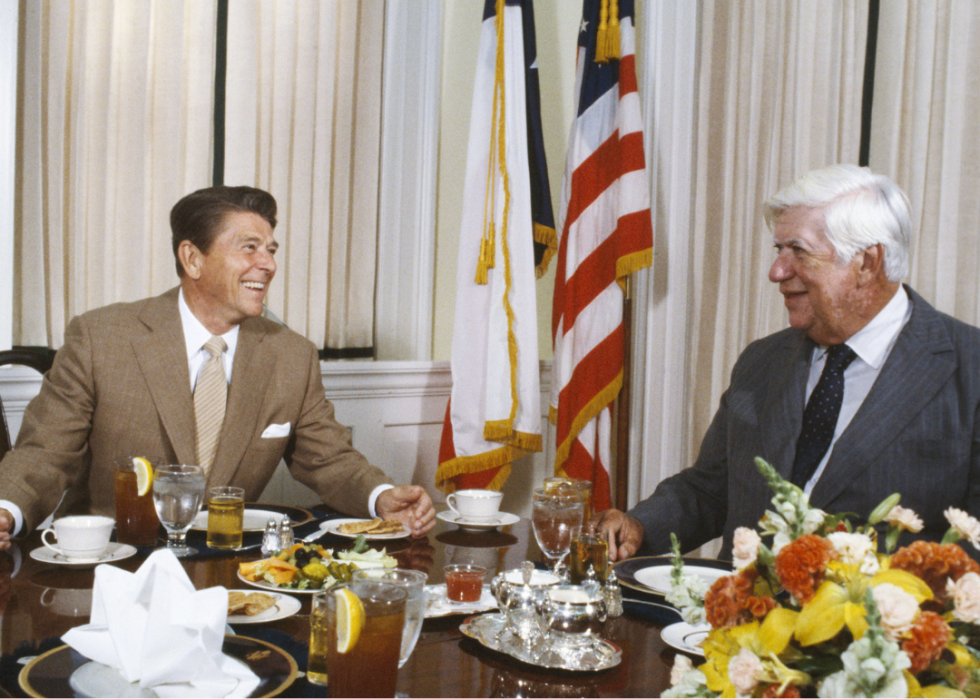
1981–1983: 97th Congress
Congress controlled by: Split
- Senate breakdown: 46 Democrats, 53 Republicans, 1 other, 0 vacancies
--- Senate controlled by: Republicans
- House of Representatives breakdown: 242 Democrats, 192 Republicans, 1 other, 0 vacancies
--- House controlled by: Democrats
- President during 1981–1983: Ronald Reagan
With Republicans controlling the Senate and a Republican president, Congress pushed through an array of tax and spending cuts. Heeding President Ronald Reagan's pro-business views, budgets at the Environmental Protection Agency, the Department of Energy, and the Occupational Safety and Health Administration underwent drastic cuts. But government spending increased, particularly on defense, and tax increases were implemented to address budget deficits.
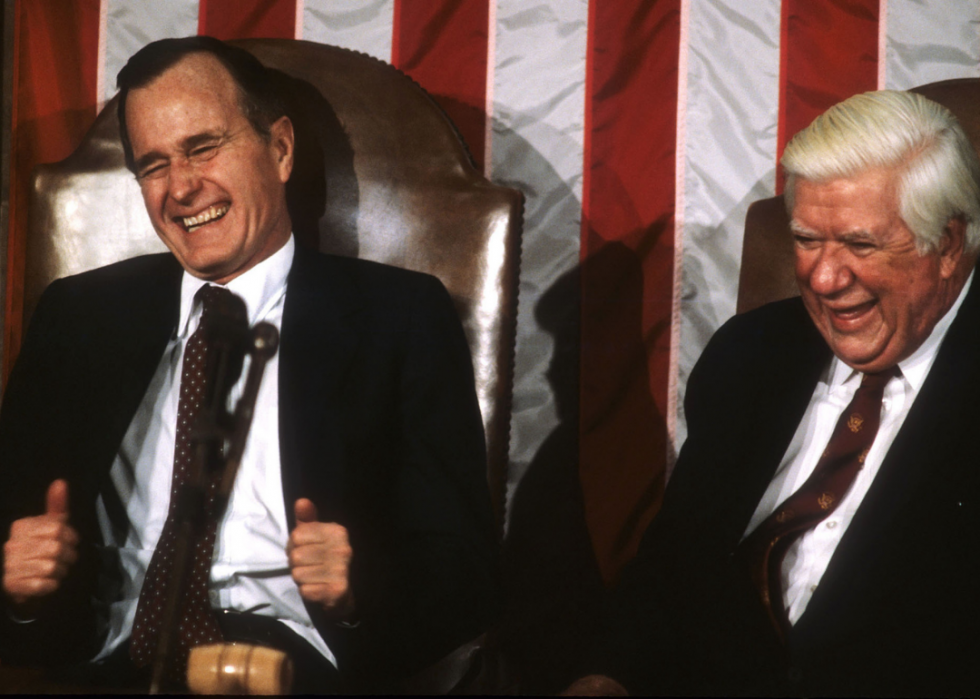
1983–1985: 98th Congress
Congress controlled by: Split
- Senate breakdown: 46 Democrats, 54 Republicans, 0 others, 0 vacancies
--- Senate controlled by: Republicans
- House of Representatives breakdown: 269 Democrats, 165 Republicans, 1 other, 0 vacancies
--- House controlled by: Democrats
- President during 1983–1985: Ronald Reagan
With Republicans controlling the Senate and Democrats growing their majority in the House, the two chambers could not agree on measures to address a growing budget deficit. Congress and the president clashed over the role of the U.S. peacekeeping mission in Beirut, where the U.S. Marine barracks were blown up by a truck bomb; and over efforts by the administration to overthrow the leftist Sandinista government in Nicaragua. Revelations that the United States was funneling money and arms to the pro-U.S. Contra forces prompted Congress to reduce assistance and in 1984 to pass an amendment forbidding U.S. agencies from providing the Contras with aid.
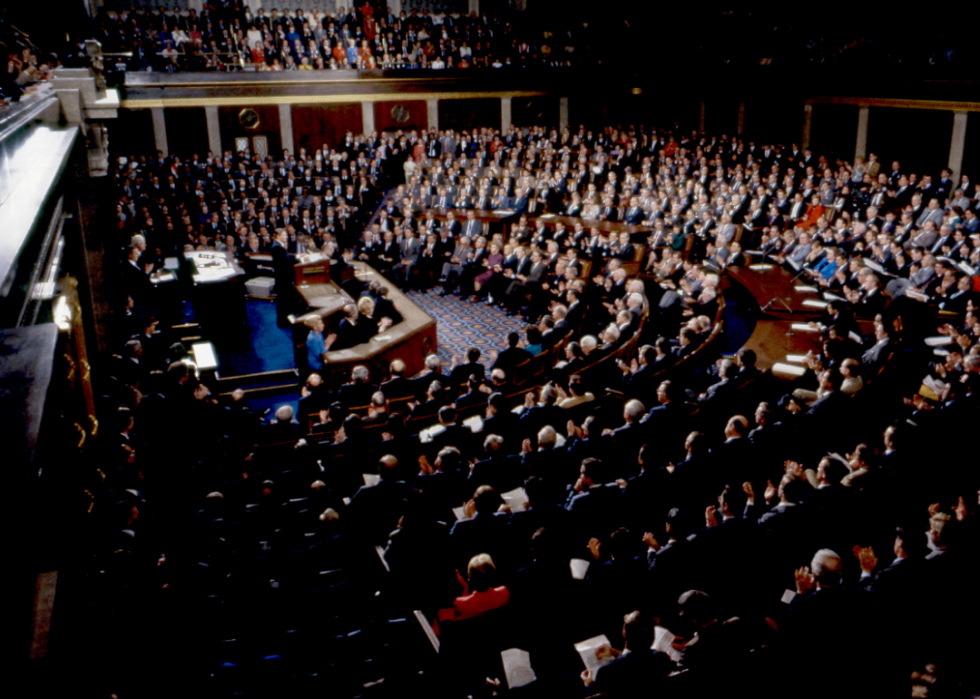
1985–1987: 99th Congress
Congress controlled by: Split
- Senate breakdown: 47 Democrats, 53 Republicans, 0 others, 0 vacancies
--- Senate controlled by: Republicans
- House of Representatives breakdown: 253 Democrats, 181 Republicans, 1 other, 0 vacancies
--- House controlled by: Democrats
- President during 1985–1987: Ronald Reagan
With a split Congress and a Republican in the White House, lawmakers grappled with the nation's budget crisis. They passed a sweeping overhaul of the tax code that dramatically lowered the corporate tax rate to 34% from 46% and lowered the top income tax rate to 28% from 50%. The Gramm-Rudman-Hollings Act, passed in 1985, implemented automatic spending cuts to take effect if Congress and the president failed to agree on how to reduce the deficit.

1987–1989: 100th Congress
Congress controlled by: Democrats
- Senate breakdown: 55 Democrats, 45 Republicans, 0 others, 0 vacancies
--- Senate controlled by: Democrats
- House of Representatives breakdown: 258 Democrats, 177 Republicans, 0 others, 0 vacancies
--- House controlled by: Democrats
- President during 1987–1989: Ronald Reagan
Facing an economic crisis and a stock market crash in 1987, the Democratic Congress and Republican administration held a so-called budget summit to address worsening spending and deficit issues. In 1987, Congress jeld joint hearings to investigate secret military assistance to Iran and to the pro-U.S. Nicaraguan Contra forces. Congress overrode President Ronald Reagan's veto of a $20 billion clean water bill known as the Clean Water Act.
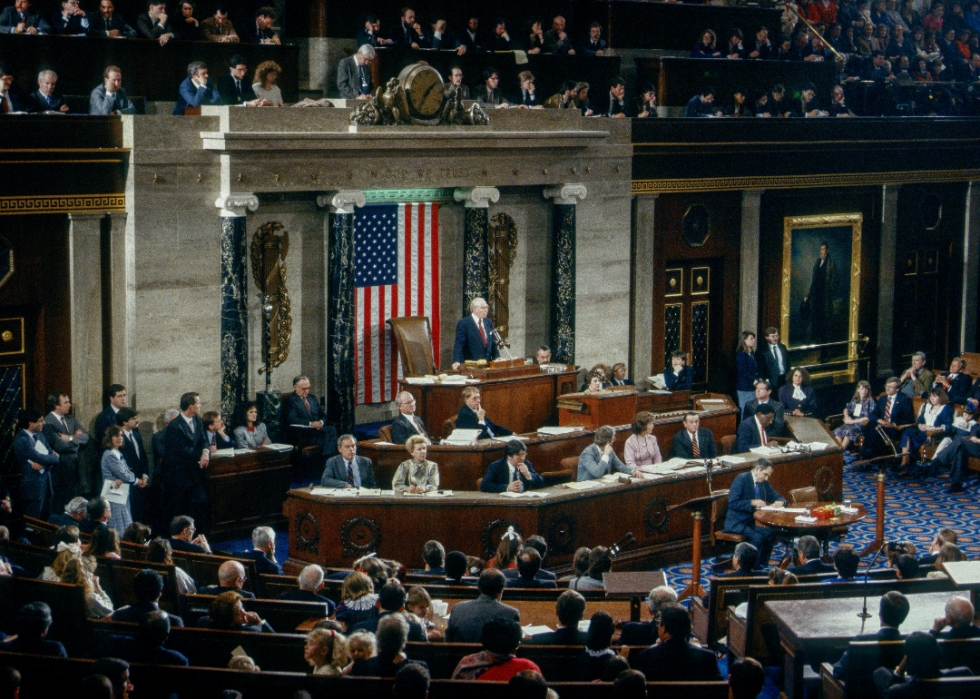
1989–1991: 101st Congress
Congress controlled by: Democrats
- Senate breakdown: 55 Democrats, 45 Republicans, 0 others, 0 vacancies
--- Senate controlled by: Democrats
- House of Representatives breakdown: 260 Democrats, 175 Republicans, 0 others, 0 vacancies
--- House controlled by: Democrats
- President during 1989–1991: George H. W. Bush
With Democratic majorities in both legislative houses, and a Republican president, Congress raised taxes to address the nation's budget deficit. It also established the Resolution Trust Corporation, a temporary federal agency designed to oversee failed savings and loan institutions that became insolvent due to unsound practices. Congress approved the landmark Americans With Disabilities Act that prohibits discrimination and guarantees equal opportunities to people with disabilities.
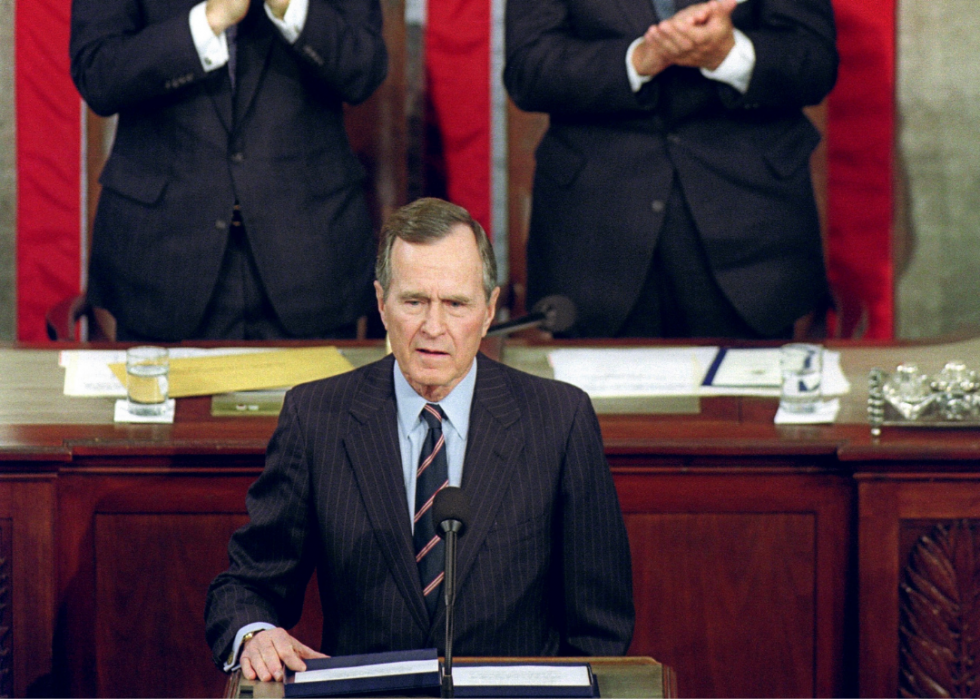
1991–1993: 102nd Congress
Congress controlled by: Democrats
- Senate breakdown: 56 Democrats, 44 Republicans, 0 others, 0 vacancies
--- Senate controlled by: Democrats
- House of Representatives breakdown: 267 Democrats, 167 Republicans, 1 other, 0 vacancies
--- House controlled by: Democrats
- President during 1991–1993: George H. W. Bush
Congress approved the use of force against the Iraqi military after its invasion of Kuwait, with the House passing the Persian Gulf Resolution that authorized President George H.W. Bush to use force against the Iraqi military. The Senate ratified the Strategic Arms Reduction Treaty, known as START 1, that called for steep cuts in U.S. and Soviet production of long-range missiles and bombers, and Congress passed a temporary, unilateral moratorium on the underground testing of nuclear weapons.
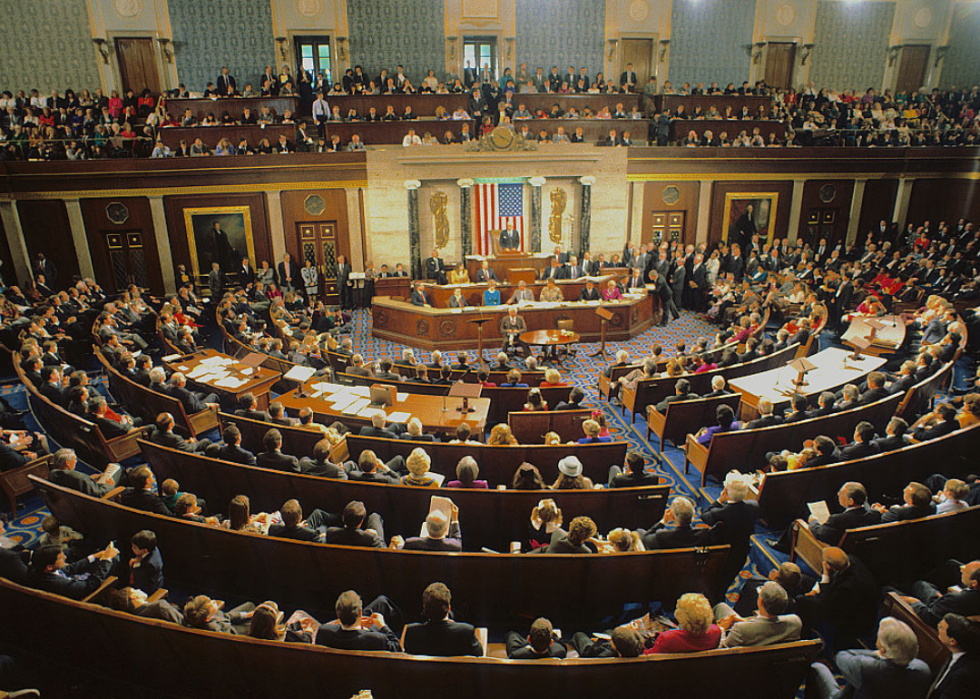
1993–1995: 103rd Congress
Congress controlled by: Democrats
- Senate breakdown: 57 Democrats, 43 Republicans, 0 others, 0 vacancies
--- Senate controlled by: Democrats
- House of Representatives breakdown: 258 Democrats, 176 Republicans, 1 other, 0 vacancies
--- House controlled by: Democrats
- President during 1993–1995: Bill Clinton
With Democrats in control of the White House and Congress, lawmakers turned their attention to international trade. Congress approved the North American Free Trade Agreement, or NAFTA, which eliminated trade barriers and tariffs among the United States, Mexico, and Canada; and the General Agreement on Tariffs and Trade, or GATT 94, to liberalize and expand global trade. The Family and Medical Leave Act was passed, allowing eligible employees to take unpaid leave for reasons including births, adoptions, and family health issues.
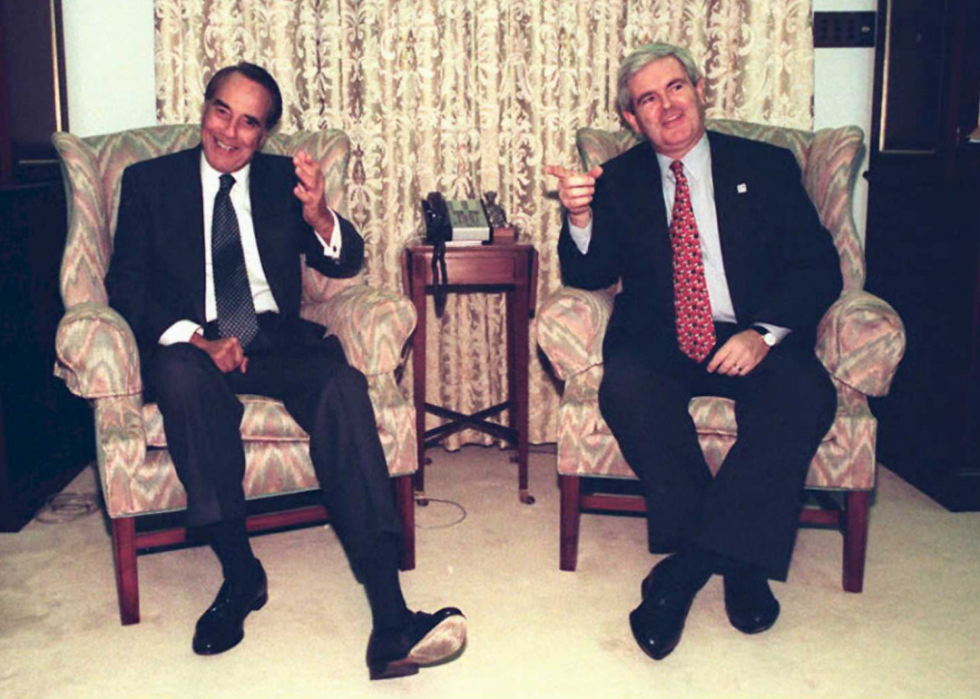
1995–1997: 104th Congress
Congress controlled by: Republicans
- Senate breakdown: 47 Democrats, 53 Republicans, 0 others, 0 vacancies
--- Senate controlled by: Republicans
- House of Representatives breakdown: 204 Democrats, 230 Republicans, 1 other, 0 vacancies
--- House controlled by: Republicans
- President during 1995–1997: Bill Clinton
Republicans enjoyed control of both the House and the Senate for the first time in four decades. House Speaker Newt Gingrich issued a conservative agenda called "Contract With America," which called for tax cuts, smaller government, and fewer regulations. Budget stalemates between President Bill Clinton and Congress forced the government to shut down twice. A welfare reform bill imposed work requirements to get benefits and put limits on the length of benefits as well.
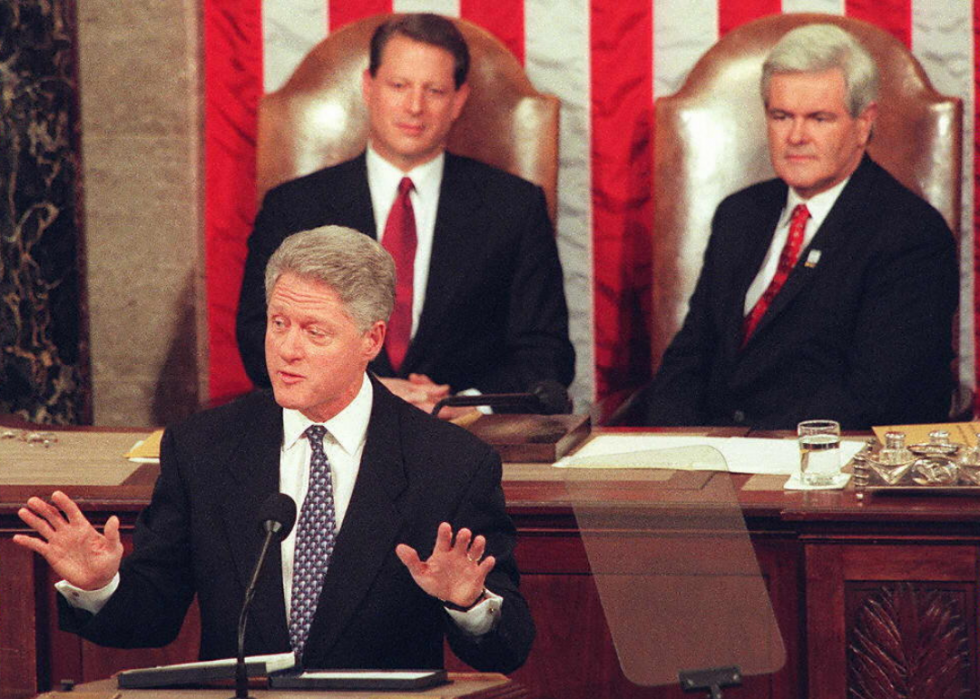
1997–1999: 105th Congress
Congress controlled by: Republicans
- Senate breakdown: 45 Democrats, 55 Republicans, 0 others, 0 vacancies
--- Senate controlled by: Republicans
- House of Representatives breakdown: 206 Democrats, 227 Republicans, 2 others, 0 vacancies
--- House controlled by: Republicans
- President during 1997–1999: Bill Clinton
The 105th Congress was preoccupied with the misdeeds of President Bill Clinton after an independent counsel report stemming from a sexual affair the president had with a White House intern. The House approved two articles of impeachment against Clinton, who was the second president to be impeached by Congress, after Andrew Johnson. President Donald Trump would later become the third.
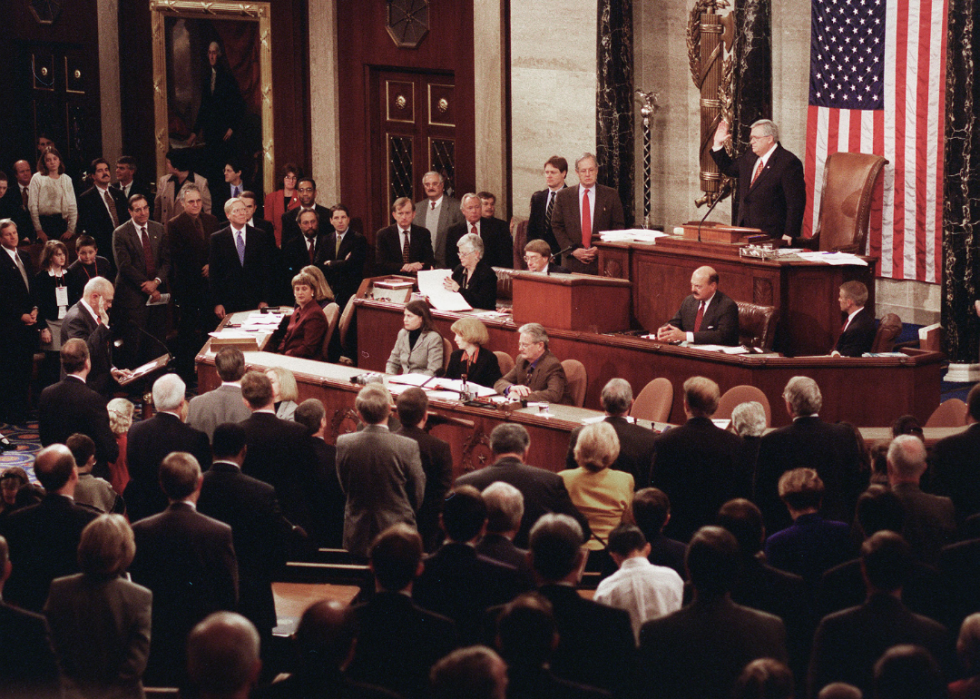
1999–2001: 106th Congress
Congress controlled by: Republicans
- Senate breakdown: 45 Democrats, 55 Republicans, 0 others, 0 vacancies
--- Senate controlled by: Republicans
- House of Representatives breakdown: 211 Democrats, 223 Republicans, 1 other, 0 vacancies
--- House controlled by: Republicans
- President during 1999–2001: Bill Clinton
The Republican-controlled Senate acquitted the president of the two impeachment charges brought by the House on perjury and obstruction of justice. Among the most significant pieces of legislation to emerge from the 106th Congress was the Gramm-Leach-Bliley Act, which provided protection to customers from financial services selling their private information. It recognized that with the merger of banks, stock brokerages, and insurance companies, financial institutions would have access to massive amounts of personal information. The act requires institutions to store personal financial information securely, advise customers of their sharing policies, and give consumers the ability to opt-out of some sharing of their personal financial information.

2001–2003: 107th Congress
Congress controlled by: Split
- Senate breakdown: 50 Democrats, 50/49 Republicans, 0/1 other, 0 vacancies
--- Senate controlled by: Democrats
- House of Representatives breakdown: 212 Democrats, 221 Republicans, 2 others, 0 vacancies
--- House controlled by: Republicans
- President during 2001–2003: George W. Bush
Congress was split, with the Senate divided 50-50 for the first time. Initially this put Democrats in control while Democratic Vice President Al Gore was still in office and had the tie-breaking vote. The majority went to the Republicans when Vice President Dick Cheney took office in January 2001. Then Vermont Republican James Jeffords switched to become an Independent, giving the majority back to the Democrats. In the wake of the terror attacks of Sept. 11, 2001, Congress authorized the use of force in Iraq and Afghanistan; set up the Department of Homeland Security, integrating 22 federal agencies and departments into one; and passed the Patriot Act, which strengthened the powers of authorities to monitor and investigate potential financing of terrorism.
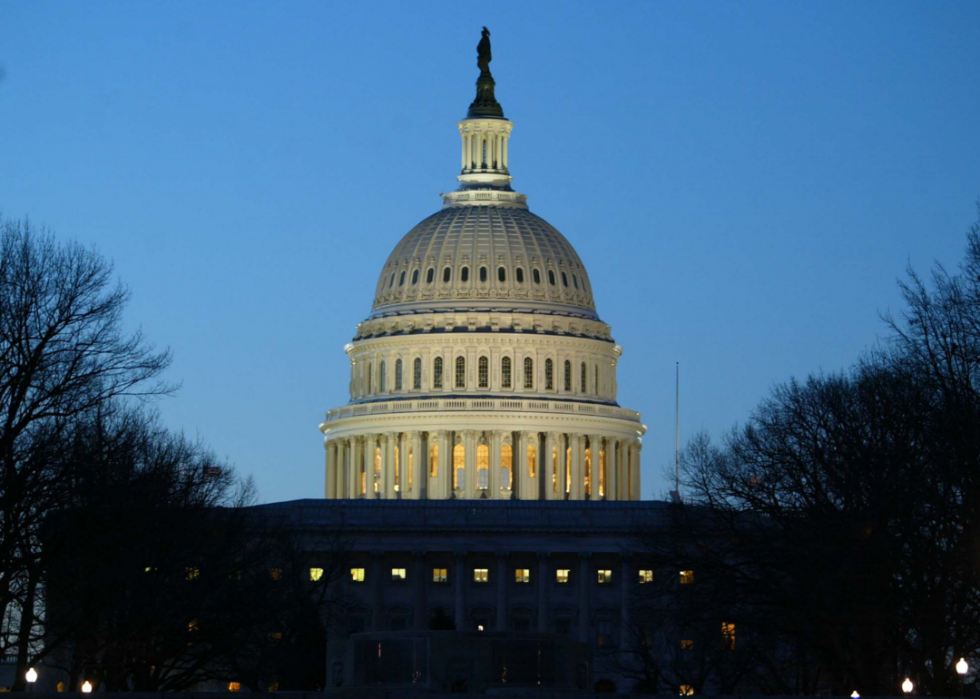
2003–2005: 108th Congress
Congress controlled by: Republicans
- Senate breakdown: 48 Democrats, 51 Republicans, 1 other, 0 vacancies
--- Senate controlled by: Republicans
- House of Representatives breakdown: 205 Democrats, 229 Republicans, 1 other, 0 vacancies
--- House controlled by: Republicans
- President during 2003–2005: George W. Bush
Republicans had narrow majorities in the Senate and House, and laws were passed giving prescription drug benefits to Medicare recipients and enacting a $350 billion cut in income, dividend, and capital gains tax rates. But the House rejected a proposal to bring back a military draft, and only four out of 13 regular spending bills were passed, leaving the government operating on stop-gap spending authorities. Priorities of the president, including an energy bill and a cap on medical malpractice liability awards, failed to pass.
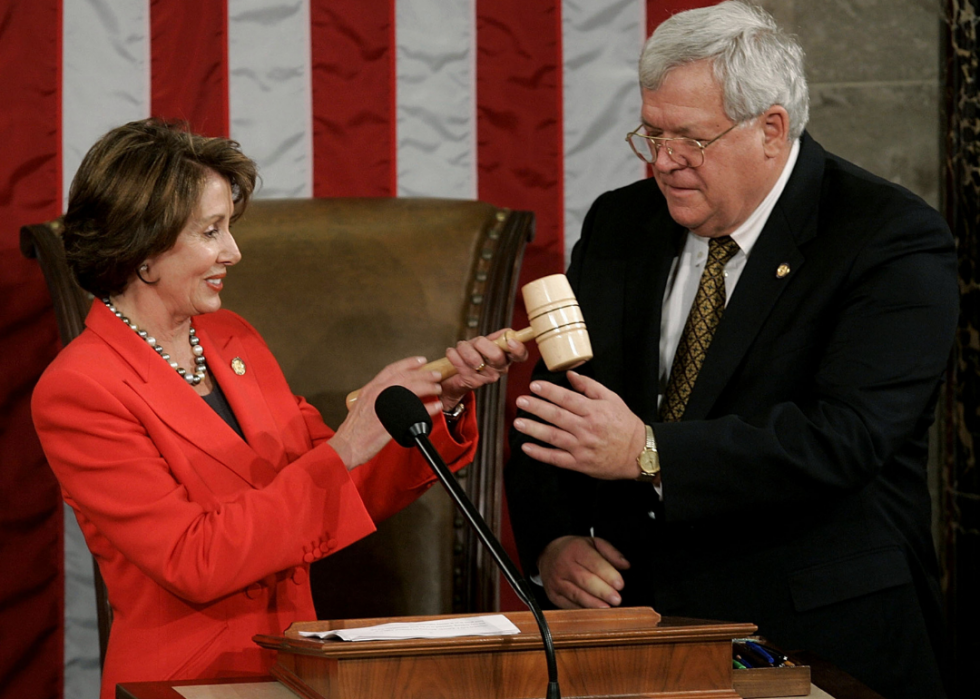
2005–2007: 109th Congress
Congress controlled by: Republicans
- Senate breakdown: 44 Democrats, 55 Republicans, 1 other, 0 vacancies
--- Senate controlled by: Republicans
- House of Representatives breakdown: 202 Democrats, 232 Republicans, 1 other, 0 vacancies
--- House controlled by: Republicans
- President during 2005–2007: George W. Bush
The 109th Congress passed relief measures for victims of Hurricane Katrina in New Orleans and along the Gulf Coast. It approved the Postal Accountability and Enhancement Act of 2006, making significant changes to the U.S. Postal Service. The act gave the USPS competitive pricing flexibility in response to changes in the global shipping market; and the rise of rival services, improved retirement benefits, and linked price increases to the rate of inflation. Legislators also reformed the funding and budgetary structure of the National Institutes of Health.
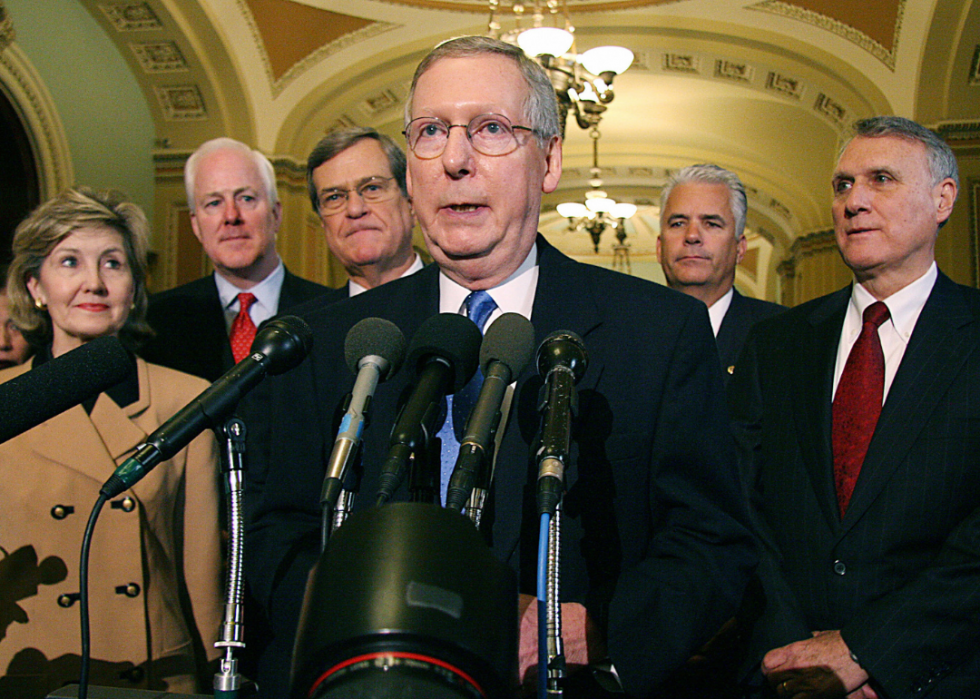
2007–2009: 110th Congress
Congress controlled by: Democrats
- Senate breakdown: 49 Democrats, 49 Republicans, 2 others, 0 vacancies
--- Senate controlled by: Democrats
- House of Representatives breakdown: 233 Democrats, 202 Republicans, 0 others, 0 vacancies
--- House controlled by: Democrats
- President during 2007–2009: George W. Bush
With Democrats controlling both Congressional chambers, the House increased the federal minimum wage and lowered the rates on student loans. Congress was occupied with foreign policy concerns in Iraq and, to address the subprime mortgage crisis, enacted an Economic Stimulus Act with tax rebates, tax cuts, higher loan limits, and incentives for capital investment. The Troubled Asset Relief Program (TARP) allocated $700 billion in government funds to purchase assets and equity of struggling companies. Nancy Pelosi became the first female speaker of the house.
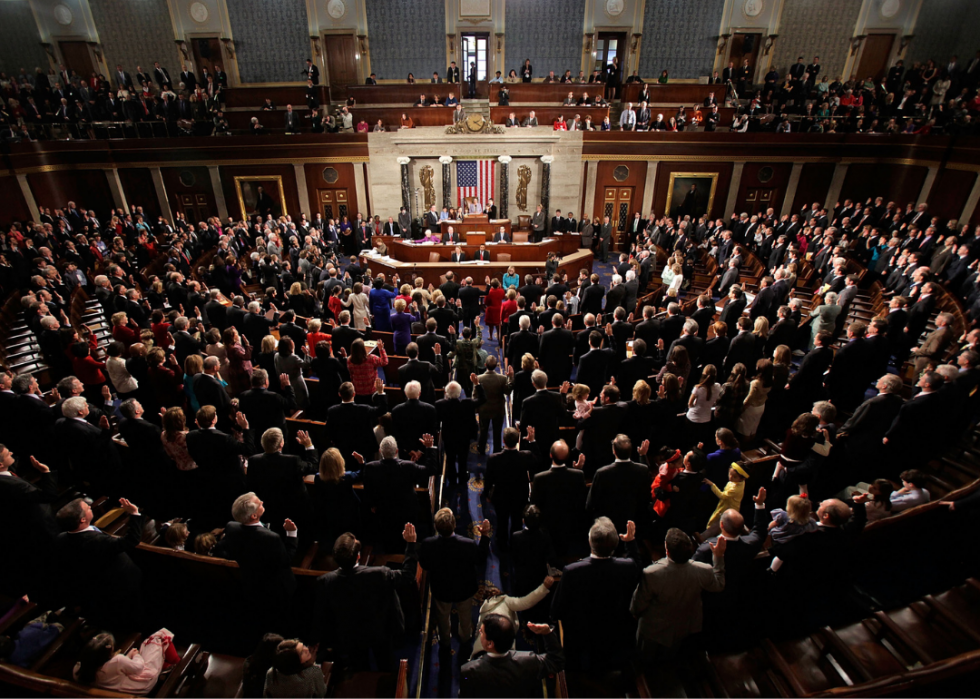
2009–2011: 111th Congress
Congress controlled by: Split
- Senate breakdown: 56–58 Democrats, 40–42 Republicans, 2 others, 0-1 vacancies
--- Senate controlled by: Republicans
- House of Representatives breakdown: 257 Democrats, 178 Republicans, 0 others, 0 vacancies
--- House controlled by: Democrats
- President during 2009–2011: Barack Obama
A split Congress passed a stimulus package and regulatory reforms to address the financial crisis and affordable health care reform that was a priority of the Obama administration. It also approved Dodd-Frank financial reforms and the Lilly Ledbetter Fair Pay Act. The Senate ended the nation's ban on gays and lesbians serving in the military, repealing the "don't ask, don't tell" policy of the Clinton administration.
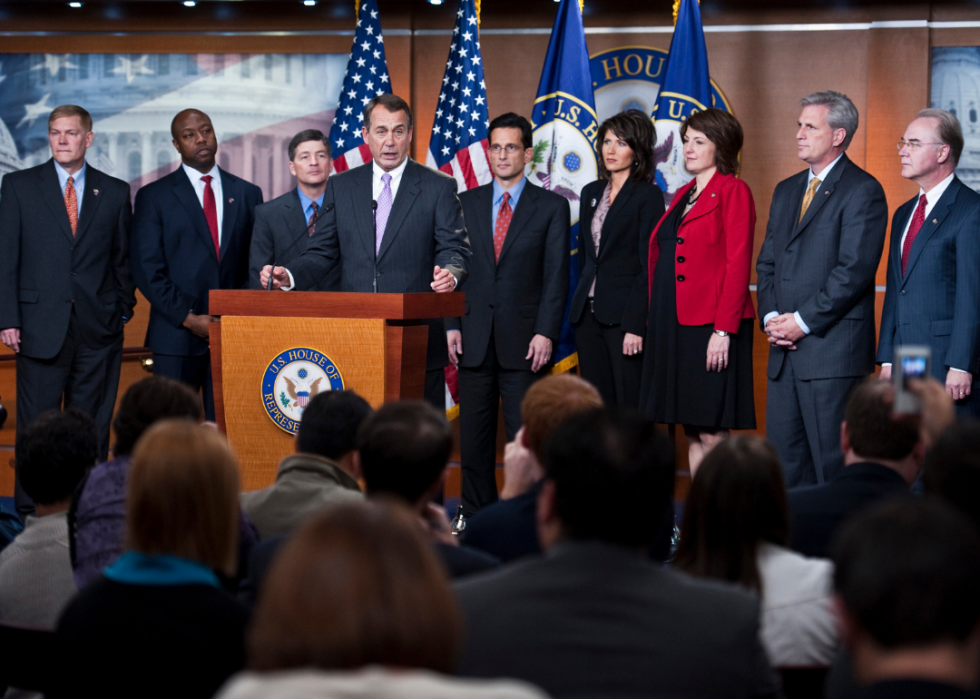
2011–2013: 112th Congress
Congress controlled by: Split
- Senate breakdown: 51 Democrats, 47 Republicans, 2 others, 0 vacancies
--- Senate controlled by: Democrats
- House of Representatives breakdown: 193 Democrats, 242 Republicans, 0 others, 0 vacancies
--- House controlled by: Republicans
- President during 2011–2013: Barack Obama
A divided Congress, combined with polarized partisan relations with the White House, failed to agree on measures to raise taxes, cut spending, and reduce the ballooning deficit. Instead, lawmakers passed emergency bills to avert defaulting on the nation's debt and forcing a shutdown of the government, and a measure to raise the debt ceiling. The 112th Congress passed about 220 public laws, the least so far of any Congress, and twice its approval rating fell to 10%, the lowest in 38 years of Gallup surveying.
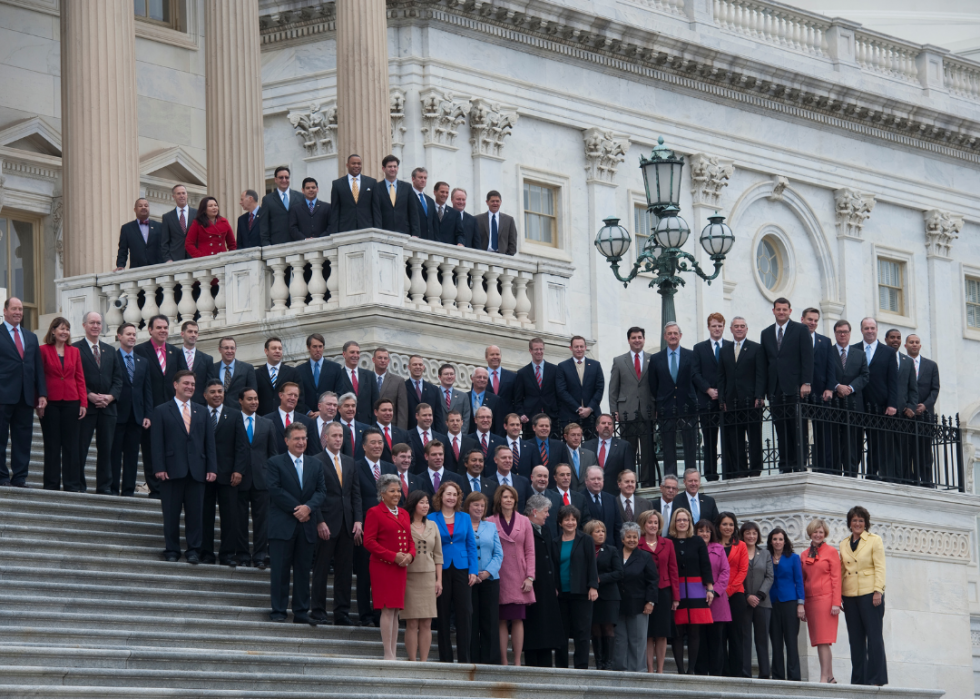
2013–2015: 113th Congress
Congress controlled by: Split
- Senate breakdown: 53 Democrats, 45 Republicans, 2 others, 0 vacancies
--- Senate controlled by: Democrats
- House of Representatives breakdown: 201 Democrats, 234 Republicans, 0 others, 0 vacancies
--- House controlled by: Republicans
- President during 2013–2015: Barack Obama
Polarized partisan disagreements among the legislative and executive branches left a number of issues unaddressed or resolved, including efforts at immigration reform. When House Republicans, led by advocates of the so-called Tea Party, tried to undermine affordable health care by linking its funding to that of the entire U.S. government, the federal government was forced to shut down for 16 days. The 113th Congress passed 296 bills that were signed into law, making it the second least-productive after the preceding 112th Congress.
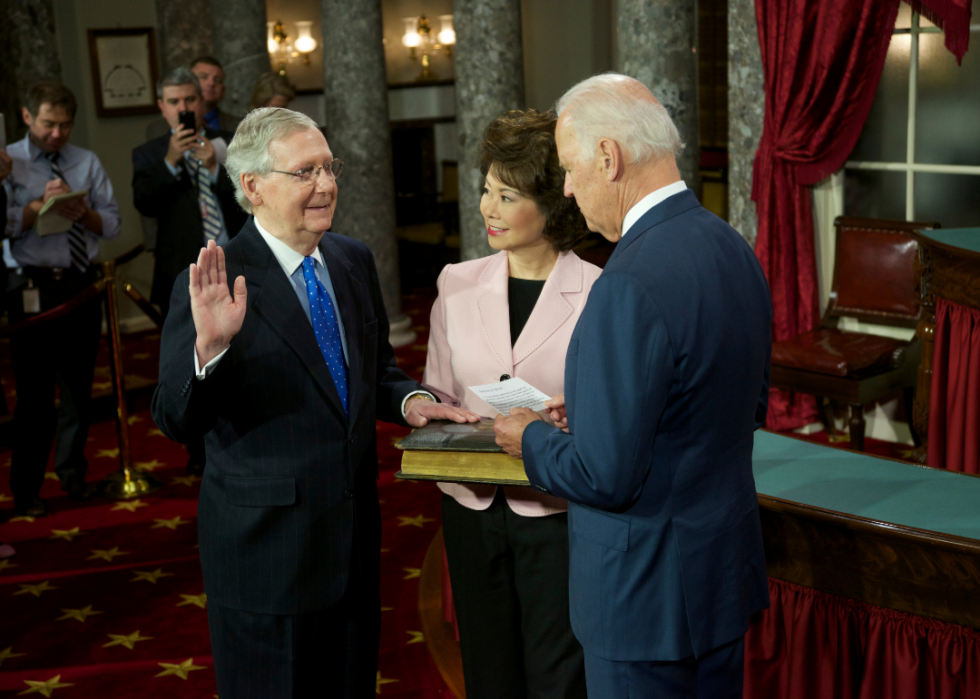
2015–2017: 114th Congress
Congress controlled by: Republicans
- Senate breakdown: 44 Democrats, 54 Republicans, 2 others, 0 vacancies
--- Senate controlled by: Republicans
- House of Representatives breakdown: 188 Democrats, 247 Republicans, 0 others, 0 vacancies
--- House controlled by: Republicans
- President during 2015–2017: Barack Obama
Congress was hampered by party infighting among Republicans and a bitter presidential contest that narrowed down to Hillary Clinton and Donald Trump. It passed the Every Student Succeeds Act that reformed the federal education guidelines set out under the previous No Child Left Behind programs, and it approved a funding deal for transportation infrastructure. In a sign of tension between the two chambers, the Senate passed less than a third of the 773 bills that passed the House.
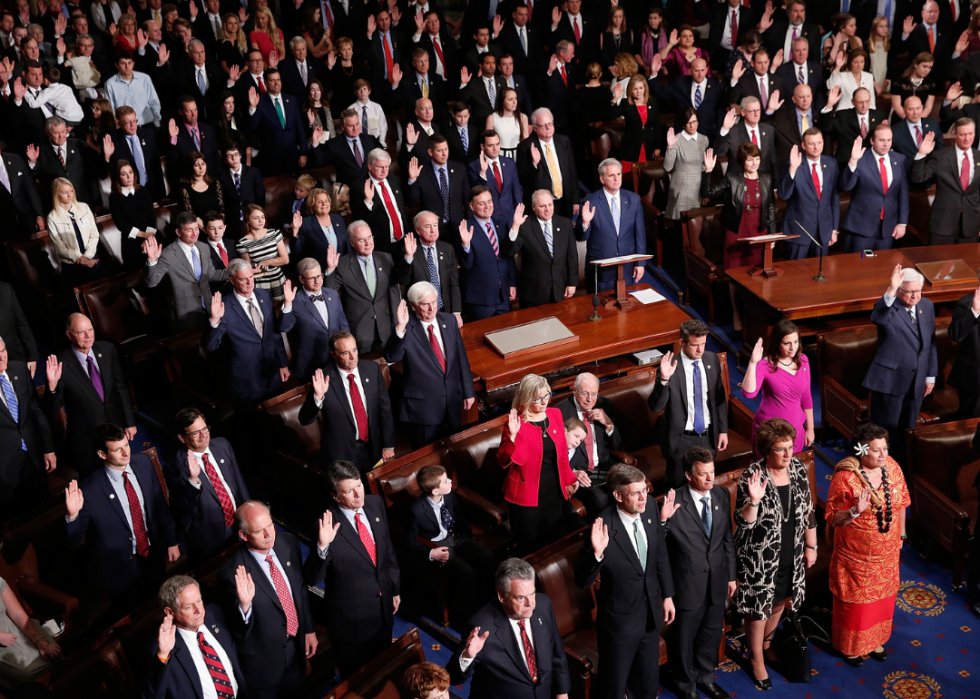
2017–2019: 115th Congress
Congress controlled by: Republicans
- Senate breakdown: 46/47 Democrats, 52/51 Republicans, 2 others, 0 vacancies
--- Senate controlled by: Republicans
- House of Representatives breakdown: 194 Democrats, 241 Republicans, 0 others, 0 vacancies
--- House controlled by: Republicans
- President during 2017–2019: Donald Trump
With Republicans in control, the 115th Congress was more active than any Congress had been in more than a decade. But a quarter of its output consisted of ceremonial moves like renaming post offices and federal buildings. Funding measures were bogged down by disputes over whether money for a border wall with Mexico would be included, but Congress did pass a package of income tax reductions for individuals and businesses, approved an overhaul of the criminal justice system that reformed sentencing and expanded job training, and authorized economic sanctions against Russia, Iran, and North Korea.
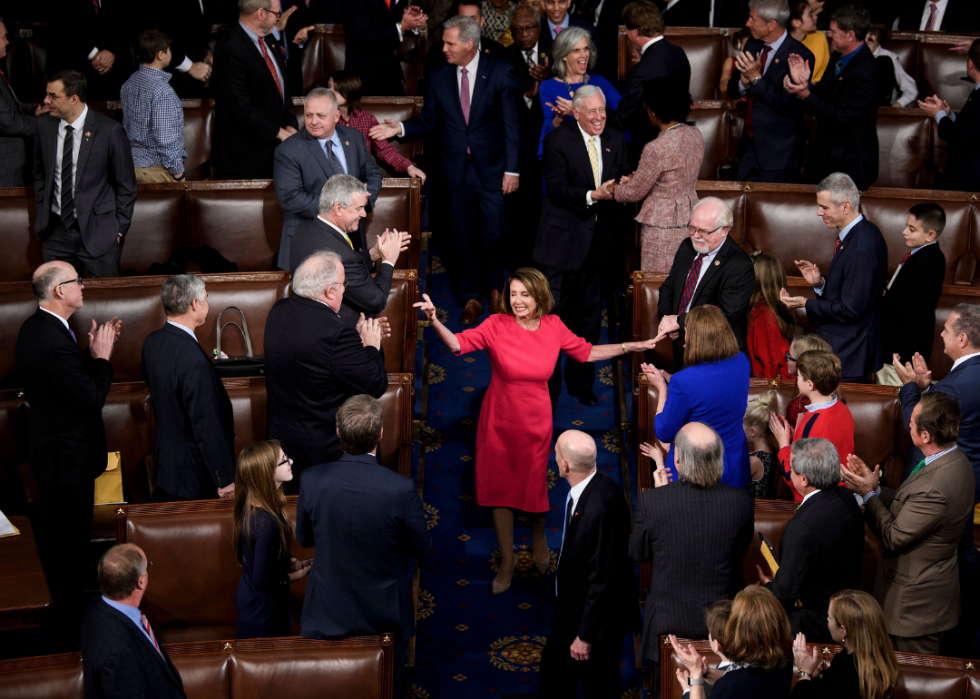
2019–2021: 116th Congress
Congress controlled by: Split
- Senate breakdown: 45 Democrats, 53 Republicans, 2 others, 0 vacancies
--- Senate controlled by: Republicans
- House of Representatives breakdown: 235 Democrats, 197 Republicans, 1 other, 0 vacancies
--- House controlled by: Democrats
- President during 2019–2021: Donald Trump
The 116th Congress broke the record to become the least productive in U.S. history, according to Common Cause, a government accountability organization that calculated that just 1% of almost 15,000 bills became law amid bitter relations between the Republican-controlled Senate and the Democratic House. Extensive investigative hearings were held as part of the Trump impeachment process, and lawmakers approved a $2.2 trillion coronavirus relief package early in the pandemic. Another coronavirus relief deal was struck just before Christmas on a $900 billion stimulus package with emergency relief checks and funds for delivering vaccines.
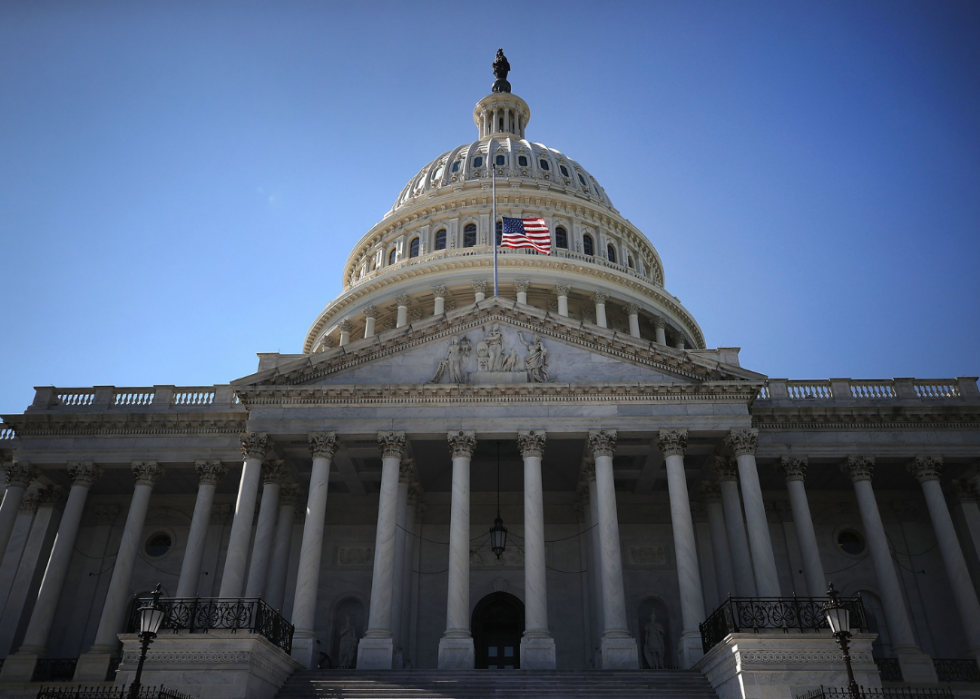
2021–2023: 117th Congress
Congress controlled by: Democrats
- Senate breakdown: 48 Democrats, 50 Republicans, 2 others, 0 vacancies
--- Senate controlled by: Democrats
- House of Representatives breakdown: 222 Democrats, 212 Republicans, 1 uncalled, 0 vacancies
--- House controlled by: Democrats
- President during 2019–2021: Joe Biden
The Senate majority was decided in two Georgia runoff elections on Jan. 5, 2021. Democrats Raphael Warnock and Jon Ossoff defeated Republican incumbents Kelly Loeffler and David Perdue, respectively, to obtain 50 seats in the Senate, including the seats of two independent senators who caucus with the Democrats. With incoming Vice President Kamala Harris being the tie-breaking vote, the Georgia wins give Democrats narrow control of the Senate. The party also kept control of the House, albeit with a smaller majority than before, and Rep. Nancy Pelosi will retain her position as Speaker.



